PinotFile: 8.13 April 8, 2010
|
Small Vines Wines: Pinot Noir Welcomes Close CompanyViticulturists speak of vine balance as the most important consideration in planting a vineyard. The term refers to the balance between vine foliage or canopy and the number of clusters of fruit. The term can also be invoked when speaking of the relative above ground growth in proportion to the vine’s root system. In either case, it is the spacing of vines that plays a critical role in determining grape quality. Vine spacing varies from 1 meter by 1 meter which is common in Burgundy and Champagne (about 4,000 vines per acre), to 8 feet by 12 feet or about 454 vines per acre which was the rule in California until the 1980s. The traditional close plantings in Burgundy allowed maximal usage of the small amount of available land making farming economically feasible. Also high density planting made sense because vineyards were historically farmed by horses, vines were often lost from disease (high density planting made up for losses), and the low vigor soils never allowed the vines to become large. The vine density in California was traditionally chosen to accommodate the tractors and implements available at the time. Many of the vineyards were planted on former apple orchards and the owners wanted to use the same tractors. Also, wider vine spacing was less risky and allowed tailoring of the vine budding to the soil vigor. Crop thinning was necessary to reduce yields and concentrate flavors. Over time, row spacing became narrower as newer, more compact farm equipment was developed and hand farming for Pinot Noir became more in vogue. Many new vineyards were planted with rows 6 feet wide and vines 4 feet apart for a total of 1,816 vines per acre. Initial plantings of Pinot Noir in the 1960s and 1070s in Oregon were often 5 feet by 10 feet or 6 feet by 8 feet (908 vines per acre). With the arrival of Burgundian influence spearheaded by Domaine Drouhin and the availability of Dijon clones, Oregon Pinot Noir vineyards planted to 1 meter by 2 meter spacing became more the norm and many California plantings have followed suite. The photos below illustrate the difference between traditional wide spaced plantings (the Olivet Lane Vineyard planted in 1975 in the Russian River Valley, above) and close spaced plantings (the DuMol Vineyard planted in 2005 in Sebastopol, below).
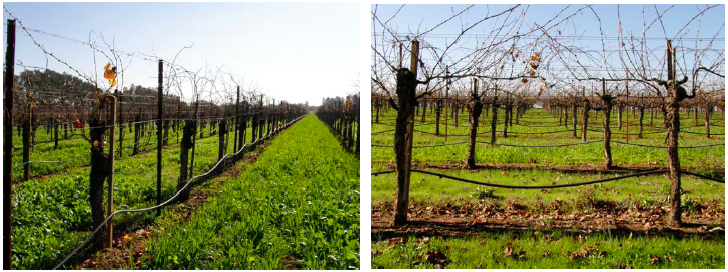
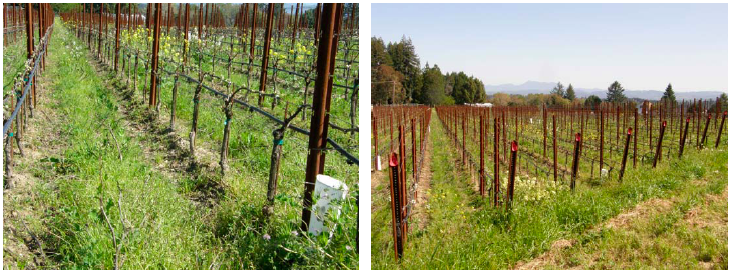 Inter row spacing (the distance between rows) is less critical for quality than within row spacing (the distance between vines). Inter row spacing has minimal influence on vine balance so it makes sense to space rows closely to achieve maximal yields from any given vineyard acreage. Within row spacing is more critical and can also be tight, allowing increased yields without reducing quality because vines often do not compete with each other. Mark Greenspan (“Vine Spacing: Is the Trend Toward High-Density Planting Going to End?”, published in Wines & Vines, December 15, 2009) analyzed data of rooting density from several different vine density plantings and found that root density continued to increase with vine density, even up to a density of 8,000 vines per acre. This tends to defuse the contention that vines compete with each other, although Greenspan notes that there are likely soils where competition might be evident. It is well known that great wines are produced from various types of vine layouts, but tight vine spacing appears to have clear advantages with Pinot Noir. High density spacing is typically 4 feet by 4 feet to 4 feet by 2.5 feet. More vines per acre can be used to yield less fruit per vine. This spacing leads to better shading, smaller vines that yield less fruit than a standard vine, and fruit that has the potential for increased quality. At the same time, the amount of vines per acre is significantly increased, insuring that the vineyard retains economic viability. Andy Humphrey, former Vineyard Manager for Archery Summit discussed close spacing in an article titled “Yield Versus Quality,” by Jordan P. Ross (www.enologyinternational.com). He said, “Keeping yields per vine low to achieve ripeness while increasing the number of vines per acre to attain economic yields is what the French have known for many years. You can make excellent wine with 6 feet by 9 feet spacing, but you have to get the yield per vine down so low that you can’t stay in business.” Tight spacing does come at a cost, for it requires more vines to be planted, more labor, more attention, more irrigation lines, and specialized farming equipment. Viticulturists emphasize that yield per acre, usually expressed as tons per acre and often reported in the wine press is not a badge of quality. Many wineries use yield per acre in their marketing promotional material which is misleading to the consumer who often does not understand the true meaning of this indicator. Jordan P. Ross points out that, “Yield per vine is a more accurate measure of quality because a lower yield per vine means that each vine is better able to fully ripen a smaller crop load. With more vines per acre, yield per acre goes up along with quality.” Paul and Kathryn McGrath Sloan, inspired by a clear understanding of the advantages of close-spaced, compact vines, launched Small Vines Viticulture (SVV) in Sonoma County in 1998. The name reflects the simplicity of their underlying philosophy: smaller vines produce smaller and more intensely flavored grapes and by extension higher quality wine. Close spacing maximizes vines per acre and minimizes pounds per vine. This formula sustains profitability and increases quality which is critical when growing grapes aimed to sell at 100 times the bottle price of the wine. SVV specializes in the planning, installation and precision viticulture of close-spaced estate Pinot Noir vineyards in Sonoma County’s Russian River Valley and Sonoma Coast appellations. The viticulture company is the only one in Sonoma County specializing solely in close spaced vineyard planting. The Sloans have studied the differences in fog intrusion, temperature patterns, and rainfall between Burgundy and California, adjusting their approach to high-density planting accordingly. For example, to accommodate California’s warmer climate, they use a unique fruiting height of between 24” and 32” that is much higher than in France, where due to cooler temperatures the grapes sit right at ground level. Early attempts in California at high density planting failed to adjust for the warmer soils and resulted in overripe or baked fruit qualities in the wines. Raising the fruiting wire to address the radiant heat of California’s warmer soils while managing the canopy for better balance between pH and acids, required extensive research and proved critical. Paul Sloan is a third generation Sonoman who had his wine epiphany while working as a wine steward at Sonoma County’s popular John Ash Restaurant, when he sampled his first Le Montrachet from Burgundy. His passion was shared with then girlfriend and now spouse, Kathryn McGrath. Paul went on to win the prestigious Greenwood Ridge California State Wine Tasting Competition with partner and winemaker Mat Gustafson. The pair were considering a winery partnership but Mat pursued a career in winemaking and Paul devoted himself full time to the study and practice of viticulture. While enrolled in the Santa Rosa Junior College viticulture program, he went to work for legendary grape grower Warren Dutton of Dutton Ranch. Dutton encouraged Paul to start his own close spaced winegrowing company despite the skepticism of others. In 2004, SVV became the first viticultural company in America to import a specialized tractor specifically tailored for high density viticulture. The Caval tractor, already in use in Europe and manufactured in France was modified by Sloan to cultivate multiple rows at a time. The over-the-row function, multiple row capabilities, and compact design made the new tractor the most cost effective close-spaced cultivar to come along in years. At only 7 feet tall and 2,500 pounds, the CAVAL is road legal, and is gentle on vineyard soils and root systems. Besides shoot positioning two rows at a time, mowing and seed drilling three rows at a time, and spraying up to seven rows at a time, the CAVAL also performs hedging, leaf removal, French plowing, compost spreading and fruit hauling. Sloan says, “The only thing it doesn’t do is harvest, and we prefer to do that by hand.” I saw the tractor in action when I visited recently, weeding vine rows, two at a time, and it was very impressive. A number of other pieces of specialized equipment have had to be designed and manufactured by SVV to facilitate close spaced vine farming.
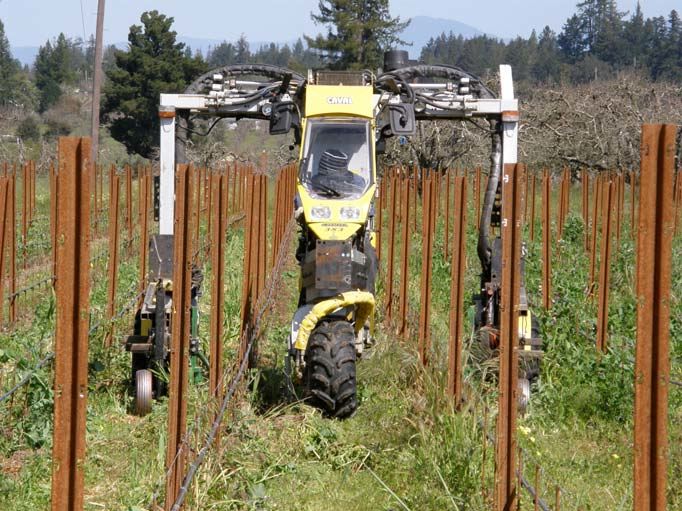 The Sloans work closely with several noted Sonoma County specialists including Daniel Roberts, PhD (“Dr. Dirt” - Viticulturist), Alfred Cass (Soils Analyst), and Mike Bobbit (GPS, Weather Mapping Specialist). Clients include Terry Adams, Paul Hobbs, Sonoma Coast Vineyards and Red Car Wines. In 2005, SVV planted and farms the largest close-spaced vineyard (15 acres) in Sonoma County for DuMol Winery. A second business model emerged beginning with the 2005 vintage, when the Sloans started Small Vines Wines (SVW). They were already farming a number of vineyards to their specifications and had the opportunity to lease back the MK Vineyard located above Occidental in the Sonoma Coast which SVV had originally planted. With the availability of prime Pinot Noir fruit, they began producing small lots of ultrapremium Pinot Noir. The wines were extremely well-received and the demand has resulted in the need to allocate their small production to release list members only. Paul crafts the wines currently in association with noted winemaker consultant Byron Kosuge. At this year’s World of Pinot Noir, while tasting over 50 Pinot Noirs in the Press Room, I became enraptured by the 2007 Small Vines Russian River Valley Pinot Noir. This was clearly the best wine I sampled over a two day period. I spoke with the Sloans and offered my congratulations. I visited them recently, spending time at three of their vineyards, MK Vineyard, the DuMol Winery vineyard, and the Sloan’s estate vineyard, and tasting their 2007 and 2008 Pinot Noirs. Unfortunately, the 2007 vintage is sold out, but the equally impressive 2008 Small Vines Pinot Noirs are available this spring. Happily, more wine was produced in the 2008 vintage.
 2007 Small Vines Russian River Valley Pinot Noir 14.3% alc., pH 3.78, 277 cases, $50. 50% Baranoff Family Vineyard, 42% MK Vineyard, 8% Old Mill Vineyard (all 6 to 8 year old vines). Organically farmed 4 feet by 4 feet and 4 meter by 4 meter (2722-3350 vines per acre). Yields 1.1-2.5 lbs. per vine. Clones: Dijon 113, 114, 115, 459, 667, 777, and Swan. Native yeast fermentation and MLF. Aged 15 months on fine lees in 50% new French oak. Unfined and unfiltered. · Moderately deep reddish-purple color in the glass. Impressively fruity nose composed of spiced cherries and berries that is very pure and vivid. Delicious core of red cherries, strawberries and raspberries, nicely spiced with accents of cola, caressing in the mouth with a finish that sails along. A pretty and polished wine that is quintessential Russian River Valley Pinot Noir.
2007 Small Vines MK Vineyard Sonoma Coast Pinot Noir 14.3% alc., pH 3.68, 147 cases, $65. Organically farmed. Clones: Dijon 114, 115, 667 and 777. Native yeast fermentation and MLF. Aged 15 months on fine lees in 66% new French oak, unfined and unfiltered. Tasted at the Sloan’s estate vineyard. · A striking wine with a little more tannic backbone, more earthiness and darker fruits than the Russian River Valley bottling. Lightly oaked, with a spicy and tenacious palate and great persistence.
The 2008 Small Vines Russian River Valley Pinot Noir and 2008 Small Vines MK Vineyard Pinot Noir follow in the same path as the above wines. Tasted at the Sloan’s estate vineyard prerelease, they are equally generous wines that are still youthful. They reflect their respective appellation terroirs beautifully, with the Russian River Valley bottling more fruity and spicy and the Sonoma Coast bottling possessing more structural bones, firmness and feral qualities. Both are very highly recommended. Photo below shows Paul, myself and my pinotphile friend, Ed Buckley, sampling Small Vines Pinot Noirs in the Sloan’s “tasting room” under a redwood grove with the Sloan’s estate vineyard visible in the background.
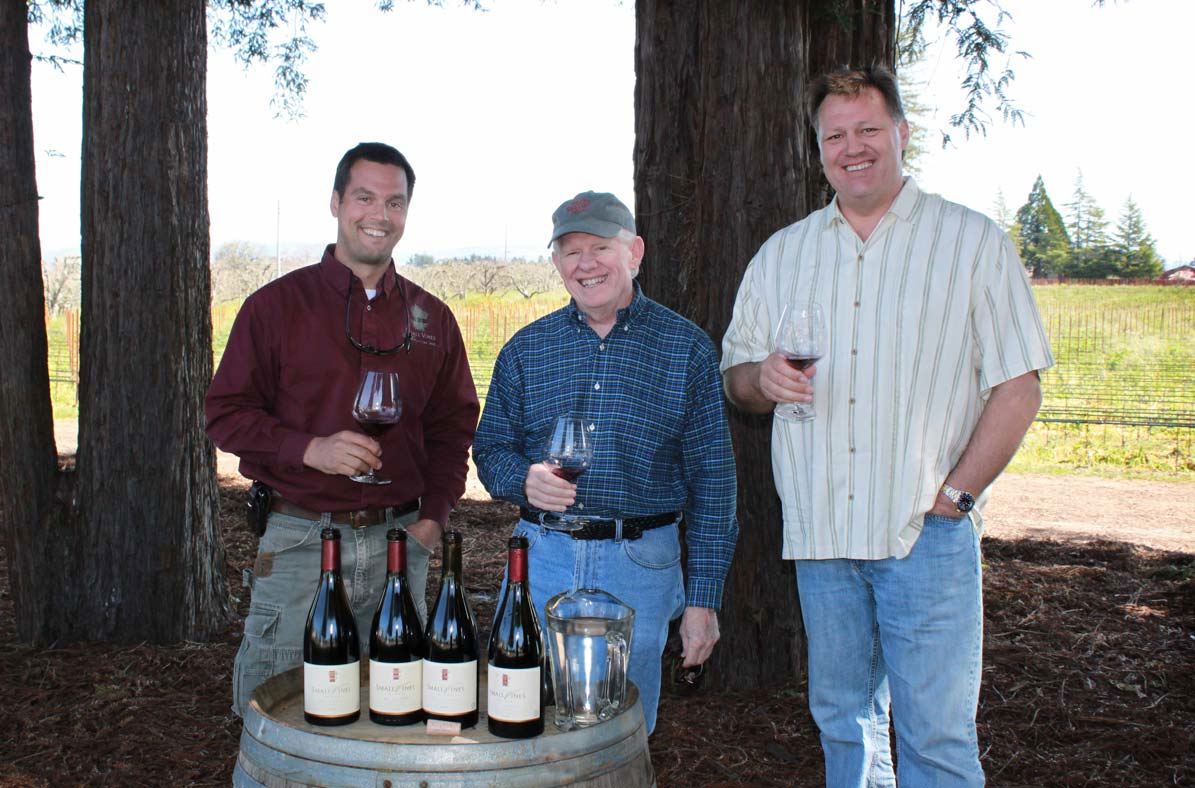 The Sloans are very passionate and innovative winegrowers who also craft extraordinary wines. I would suggest you join their release list to guarantee access to future releases. The 2008 Small Vines Russian River Valley Pinot Noir was just released, and the 2008 Small Vines MK Vineyard, with only 150 bottles available, will be released in the fall primarily to mailing list members. Follow the informative Small Vines Blog and videos at www.smallvines.com/blog. 2160 Green Hill Road, Sebastopol. 707-823-0886. Bud break in mid-March in the Russian River Valley:
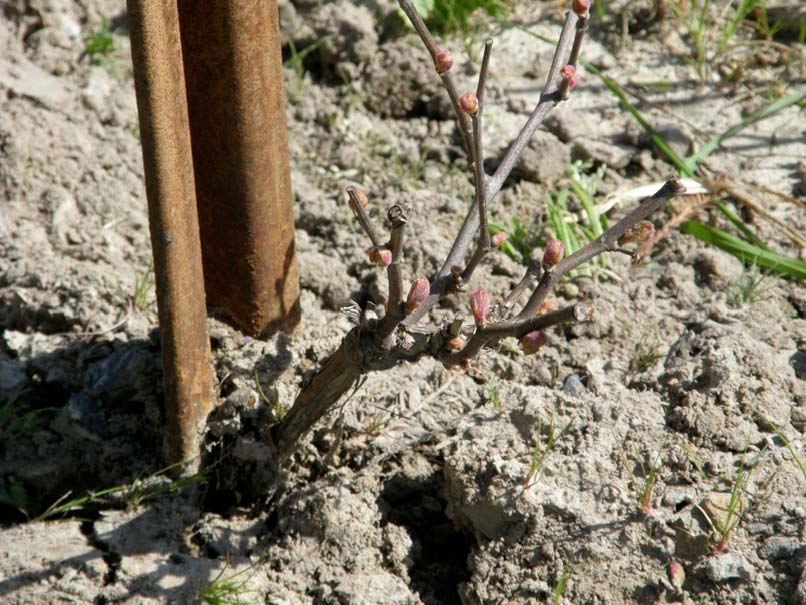
Pinot Noir Blanc: The Essence of Pinot NoirA commonly heard expression is that Pinot Noir is a white wine masquerading as a red wine. The pulp and juice of the Pinot Noir grape are clear (white) and most of the flavors, aromas, and all the color of Pinot Noir comes from the skins. A white wine can be produced from Pinot Noir if the grapes are pressed after harvesting avoiding any skin contact with the juice. The resulting wine is the essence of Pinot Noir grape juice or Pinot Noir Blanc. Thomas Houseman, winemaker for Anne Amie Vineyards in the Yamhill-Carlton District of the Willamette Valley, turned me on to Pinot Noir Blanc. He crafts an example labeled “Prismé” and told me it was his favorite wine to make. I pressed him to find out what turns him on about Pinot Noir Blanc. Here is what he told me. “Why do I like to make this wine so much? I guess it comes down to the wine itself. It is called Prismé, in honor of prisms which split light into its color components, only in reverse. I guess a better name would have been Msirp, but that is plain weird. What I love about this wine is that it is similar to a full-bodied Pinot Noir that has been stripped of all the wainscoting. It is rich, toasty and viscous, with the balanced acidity of Oregon Pinot Noir, but it is nearly clear. It does not hide anything. It shows its provenance and the hand of the winemaker. I also revel in how this wine evolves over time, from salmon-colored juice, to pineapple fermentation aromatics, to buttery, leesy aromas, to toasty, flavors and finally to all those traits in an envelope that show the evolution of the wine. I have been practicing bonsai since I was 13 years old. What I love about bonsai is walking into a nursery and seeing a weedy little plant that has potential and form. For me, Prismé is that. The vineyards we pull from make wine with great structure. They make great Pinot Noir, but also have the potential to be shaped into something entirely different. That is what I do with the juice. I take a natural form and shape it into something I envision in my mind that is graceful and reflects my ideal of what I see in the grape. Like bonsai, it takes time, meditation and focus. I have watched the 2007 Prismé evolve and soften since we released it. It is in a place now where I’d liked to have seen it when we released it. Each vintage of Prismé will have its own structure. The person shaping the wines will be me. It is vintage, vineyard and clone in its purest form shaped and nurtured by me. It is Pinot Noir without the red.” Pinot Noir Blanc was a central player in the acrimonious parting of winemaker Anthony Rynders from Domaine Serene in 2009. A number of allegations were made by Domaine Serene against Rynders, but one main issue was the winery’s winemaking process used to produce its Coeur Blanc white wine from Pinot Noir grapes. Domaine Serene was concerned that Rynders would use the winery’s proprietary winemaking process to make his own competing Pinot Noir Blanc. Rynders argued that the method of making white wine from Pinot Noir grapes is not proprietary and common knowledge to many winemakers. Houseman described his method of crafting Pinot Noir Blanc. “It is a bit of beast to make. It takes up my entire crew and the whole winery, as we whole cluster press the fruit. It requires a crew to sort the grapes as they go into the press. Once the press is filled (the fruit is inside for a maximum of five minutes before the press is emptied), the grapes are again sorted and made into Pinot Noir Blanc, thus requiring two crews and a whole winery to make it. The press liberates free-run juice. We settle the juice overnight, then rack into French oak puncheons (25% new), where we use several aromatic yeast strains to ferment to dryness. This is a slow process! Once primary fermentation is over, the wine goes through full malolactic fermentation and lees stirring until we get the rich, viscous, toasty flavors I am looking for. At this point we will rack the wine to neutral barrels and age the cuvée on its lees until bottling for a full 18 months.” Pinot Noir Blanc should not be confused with Pinot Blanc which is a white grape genetic mutation of Pinot Noir. It is often confused with Chardonnay and wineries vinify it in a similar style, using barrel fermentation, new oak and malolactic fermentation. It can also be made into a crisper wine that can age. Tony Soter at Etude pioneered Pinot Blanc in California and several Oregon producers, particularly The Four Graces, have produced exemplary versions. I recently reviewed three excellent examples of Pinot Noir Blanc, all from the Willamette Valley of Oregon. These are fascinating wines meant to challenge the palate accustomed to the aroma and flavor profile of traditional red Pinot Noir. Nothing quite like it.
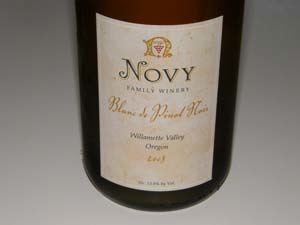 2008 Novy Family Wines Willamette Valley Blanc de Pinot Noir 13.9% alc., 117 cases, $25, released October 2009. Produced from a block of Arbre Vert Vineyard planted to Dijon 115 clone which did not reach full ripeness in 2007. Whole cluster pressed, allowed to settle for a day, and drained into a combination of stainless steel and older oak barrels. Fermentation continued and the wine went through partial malolactic fermentation. · Light apricot color in the glass. Aromas of baked bread, mocha, oak and pear. Delicate flavors of pears, toast and orange flower water. Welcome acidity without tannins. An appropriate aperitif or perfect accompaniment to lighter fare and best served slightly chilled. Good.
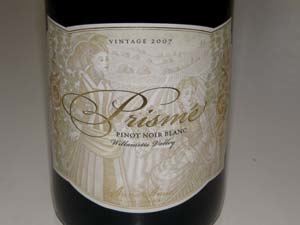 2007 Anne Amie Prismé Willamette Valley Pinot Noir Blanc 14.1% alc., pH 3.43, 390 cases, $45, released November 2009. Pommard clone. · Light apricot color in the glass. Interesting aromatic nuances of papaya, peach, coconut and paraffin. Seductive and understated on the palate with pleasing flavors of white peaches, honey, cookie dough, almonds and lychee. Very creamy with bright acidity and polished tannins. An unusual and captivating wine that is full of unexpected charm. Dreamy with shellfish. Very good (+).
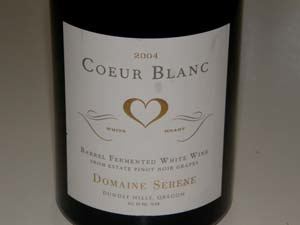 2004 Domaine Serene Willamette Valley Coeur Blanc “White Heart” 14.5% alc., 450 cases, $75. Barrel fermented white wine from estate Pinot Noir. Gently pressed whole clusters have limited contact with the skins so only the essence or white heart juice is expressed. Aged 16 months on the lees in 30% new French oak and 12 months in bottle. Winemaker was Tony Rynders. Produced in the 2004, 2005, 2006 and 2008 vintages. · Light apricot color in the glass. Potent aromas of gardenias, paraffin, buttered popcorn and marzipan. Rich and delicious flavors of pears, canned peaches, and roasted nuts caressed by gentle oak tannins with an impressive persistence on the pleasing finish. Very good.
Novy Family Wines are a sister label to Siduri and the wines are crafted by winemaker Adam Lee. The tasting room is open for sales to the public by appointment Monday through Saturday at 980 Airway Court, Suite C, in Santa Rosa. The website is www.novyfamilywines.com and the phone is 707-578-3882. The Novy Blanc de Noir also has limited retail distribution. The Anne Amie Prismé is available for purchase online at www.anneamie.com. The Anne Amie Vineyards tasting room (photo below) is open daily March through December at 6580 NE Mineral Springs Rd in McMinnville, Oregon. Pre-orders are being taken for the 2008 Domaine Serene Coeur Blanc (600 cases, $74) at 1-866-864-6555. The Domaine Serene tasting room is open Wednesday through Monday at 6555 NE Hilltop Lane in Dayton, Oregon. The website is www.domaineserene.com.
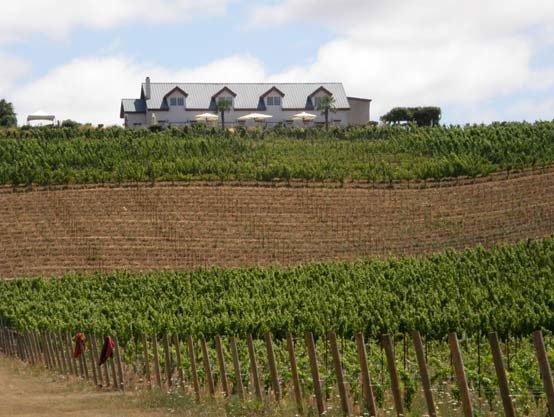
Prodigal Wines: Fifty Years in the MakingStephen Russell was an early graduate of the University of California at Davis, leaving with a degree in enology in 1960 to become E.&J. Gallo’s first formally trained enologist. He quickly discovered that corporate winemaking did not interest him, but before departing he left behind a legacy. Stephen’s claim to fame at E.&J. Gallo was his creation of a process for carbonization of Ripple! After a failed attempt to purchase the Freemark Abbey Winery, Stephen left the wine industry for good and returned to school where he obtained his DVM and PhD degrees. He pursued a very successful career in cancer research and more recently advised researchers about proper paths to acquiring research grants. In 2001, Stephen decided to do something that involved his lovely spouse, Mary, who had faithfully stood by his side through the years. Together they bought a house and land in the southeastern corner of the Sta. Rita Hills appellation, and Prodigal Wines was launched. The “prodigal” son had returned, dedicated to capturing the essence of Pinot Noir. Stephen likes to use the tag line, “A Wine Fifty Years in the Making.”
 The Russells have planted an estate vineyard consisting of four acres of Pinot Noir (Dijon clones 115, 667 and 777). The first vintage was harvested in 2005. The vineyard is named Quinta Santa Rosa and is managed by Jeff Newton of Coastal Vineyard Care. Stephen used consultants for his first vintages, but beginning with the 2007 wines, he has become the sole winemaker. The wines are crafted in a new shared facility on Santa Rosa Road in the Santa Rita Hills. I like his style, which is all about precision, restraint and elegance. Some may wish for more fruit intensity (these wines are not fruit bombs), but I prefer the delicate approach which produces more nuanced wines. All the wines have supple tannins so they are very approachable now. The 2007 wines were released April 1, 2010.
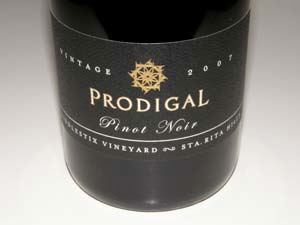 2007 Prodigal Fiddlestix Vineyard Sta. Rita Hills Pinot Noir 14.1% alc., 50 cases, $35. Clones 115, 667. Aged in 33% new French oak, bottled unfined and unfiltered. · Subdued aromas of dark berry fruits with hints of Provencal herbs and forest floor. Juicy and bright on the attack with substantial fruit intensity and noticeable fine-grain tannins. This wine has bold flavors but retains an appealing elegance. Could use another year or two in the cellar to fully integrate the tannins. Fine the next day from a previously opened and re-corked bottle. Very good.
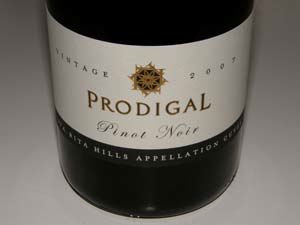 2007 Prodigal Sta. Rita Hills Appellation Cuvée Pinot Noir 14.1% alc., $35. Sourced from four vineyards: 28% Quinta Santa Rosa, 45% Fiddlestix, 15% Rancho la Viña, and 12% Rio Vista. · Delicately fruited nose with a hint of spice and smoky oak. Soft, redder fruits on the palate with notes of pomegranate and lemon cola and a citrus lift on the lively finish. A fine daily drinker. Decent.
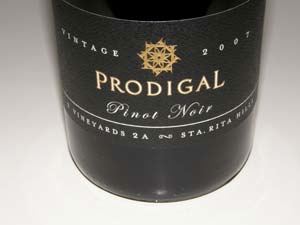 2007 Prodigal 2 Vineyards 2A Sta. Rita Hills Pinot Noir 14.1% alc., 50 cases, $45. Sourced from Rancho la Viña Vineyard at the western end of the AVA (67%) and Rio Vista Vineyard at the eastern end of the AVA (33%). 100% clone 2A (Wädenswil). · Deeper, darker red fruits featured. This wine has more bulk and mystery than the estate bottling. Moderately rich cherry and berry core set off by subtle oak spice, finishing with an appealing acidic tang. Soft tannins and thoroughly harmonious. Still drank beautifully the next day from a previously opened and re-corked bottle. Very good.
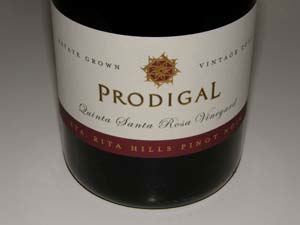 2007 Prodigal Quinta Santa Rosa Vineyard Sta. Rita Hills Pinot Noir 14.1% alc., 92 cases, $55. · The nose on this beauty is what entices me about Pinot Noir sporting vivid red fruits, nicely spiced with supporting oak. A delicate wine, but packed with flavor featuring a pleasing melange of red Pinot fruits, wrapped in enough suede tannins to bring the fruit into focus. The wine possesses both an admirable finesse and remarkable persistence on the aromatic finish and picks up interest and intensity with time in the glass. Worth the fifty year wait.
2005 Prodigal Quinta Santa Rosa Vineyard Sta. Rita Hills Pinot Noir 14.5% alc.. Inaugural vintage from this estate vineyard. The wine was crafted with winemaker Norm Yost (Flying Goat). · Darkly colored. Hi-tone fruity nose featuring black cherries and dark red berry jam. Very ripe fruit flavors with a slight roasted quality. Tasty and flashy berry and currant flavors with the slightest hint of oak. Smoothly textured with balancing acidity and a dry finish. The wine has aged nicely. This wine is crafted in a bigger, riper, more fruit-forward style than the 2007 vintage Pinot Noirs that were produced by Stephen Russell. Good.
Prodigal wines may be tasted by appointment at the winery (805-688-0476) and are conducted by either Stephen, Mary or the new assistant winemaker, Stephen Villa. The tasting usually last 1-2 hours and includes barrel tasting. The wines are also sold through a mailing list and online at www.prodigalwines.com. Look for the Russells at the upcoming Santa Barbara Vintner’s Festival on April 17 in Lompoc.
The Donum Estate: Peaking at Ten YearsNow ten years old, The Donum Estate, is leading the cadre of Pinot Noir producers in Carneros that are producing stunning wines to rival any made in California today. Since the first release in 2001, consisting of 150 cases of Donum Carneros Estate Grown Pinot Noir, the reputation of The Donum Estate has increasingly attracted reverence by Pinot Noir lovers. With the release of the 2007 vintage of Pinot Noirs, Donum has reached the fraternity of California’s top Pinot Noir producers. The superb quality of the wines have reflected winegrower and President Anne Moller-Racke’s commitment to the European model of intimate involvement in the estate vineyards. The result are wines from Donum Estate that not only exhibit regional character, they possess a sensuality that is seductive rather than overpowering. Anne was the Vineyard Manager for Buena Vista Carneros beginning in 1983. After arriving in Sonoma from Germany, she gained experience working with winegrowing authorities like Dr. Phil Freese, Andre Tchelistcheff, and Dr. Paul Skinner. She played an instrumental role in obtaining appellation status for Carneros and the formation of the Carneros Quality Alliance. In 1997, Anne was promoted to Vice President of Vineyard Operations at Buena Vista Carneros. When the Moller-Racke family sold Buena Vista to Allied Domecq in 2001, Markus and Anne Moller-Racke divorced, and Anne split off 200 acres of the Buena Vista Estate to start her personal project, The Donum Estate as well as to grow grapes for the rejuvenated Robert Stemmler label. The name, Donum, translates from the Latin to “donation” and refers to grapes as a gift of the land. Both Donum and Stemmler labels produce Pinot Noir from Carneros and the Russian River Valley. Anne has farmed the Donum Ranch for over 20 years, and a few old Martini selection Pinot Noir and old Wente Chardonnay blocks for nearly 30 years. She says, “As plant and budwood materials have matured, the vineyards have really come together. Because we have tended and tweaked them during this process, we understand our estate. Like the Burgundians, we have identified our best blocks and best portions of blocks. Some were clear from the outset, others have been nurtured and coaxed and brought forward. The luxury of this project is that it has allowed us to treat all of our sites as grand crus.” The Donum Estate vineyard plantings consist of 70 acres of the former Tula Vista Vineyard off Ramal Road and a separate 20-acre Ferguson Block Vineyard located a mile away. The clonal plantings offer an interesting history. In the late 1980s, Anne was having difficulty locating California rootstock for plantings at Buena Vista. She contacted a fellow German ex-patriot in the Finger Lakes region of New York, Hermann J. Weimer, who sold her 3,309 rootstocks from his extensive nursery in 1989-1990. Along with the rootstocks, she obtained Roederer budwood, a Pinot Noir still wine clone. This clone’s true origins remain clouded and several viticulturists do not feel it is the same as other Roederer clones from France such as those planted at Roederer in the Anderson Valley. The berries are very small with thick skins, much like blueberries, producing dark, beefy wines of great depth. This clone has been named the Donum selection and both the 2002 and 2003 Donum Pinots were made entirely from the 5.5-acre 4-90 block of this selection. The Donum Vineyard also contains several other clonal selections including Calera, Hanzell, Swan and Dijon 777. Anne has found that Dijon clones don’t perform well on her estate, seemingly better suited to other Carneros sites, or the Russian River Valley where Donum farms the 11-acre Nugent Vineyard that is planted to Dijon selections.
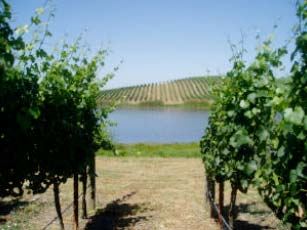 The Ferguson Block was planted in 1974 to a Martini selection on St. George rootstock. The gnarled vines are virused and Anne works hard to get yields of one ton per acre from these treasured vines. The Ferguson Block has been used in a vineyard-designated Robert Stemmler Pinot Noir and a small portion has been included in the Donuum Estate Pinot Noir in most years. The Donum Estate Pinot Noir is sourced primarily from Roederer clonal selections. In 2007, a 150-case lot was also made from a select Roederer block of the Donum Estate, the 4-90 block, and labeled as Donum West Slope Estate Grown Carneros Pinot Noir. Anne is very proud of her Carneros heritage. She talks about the old days when the land in Carneros was cheap, large parcels easily obtainable, and land was easy to develop. Prime grapes sold for only $600 per ton, and often went into sparkling wines or anonymously into blended wines. Now the scene in Carneros has changed completely. It is taken time to understand the sites and plant the appropriate selections. Anne feels strongly that, “Carneros can deliver.” Although Donum Estate Pinot Noir has become a vanguard wine for the region, Anne is not resting on her laurels. She admits, “I am constantly on a quest with Pinot Noir.” Anne started the Donum project using noted Carneros winemaker Ken Bernard to craft the wines. As production increased, it was necessary to bring on a full-time winemaker. Bernard recommended Kenneth Juhasz (“Uhaas”) who had made Pinot Noir in New Zealand and Oregon. Anne and Kenneth clicked and the partnership began in 2002. Ken Bernard has continued as a consultant for the Robert Stemmler label. I have favorably reviewed every vintage of Donum Estate Pinot Noir since 2002 and have noticed subtle refinements and improvements in style and quality that now bring the wines to the forefront in Carneros. The 2007 lineup is remarkably good and definitely worth your attention. If you have bad memories of Carneros Pinot Noirs of the past, put them to rest and explore the wines of The Donum Estate.
2007 Donum Estate Grown Carneros Pinot Noir 14.4% alc., pH 3.69, 800 cases, $65. Primarily Donum Roederer selection blended with Dijon 667, a Martini selection, and a Calera selection. De-stemmed, coldsoaked. All free-run juice. Aged 11 months in 70% new French oak. Best barrel selection. Unfined and unfiltered. · Moderately dark reddish-purple color in the glass. Savory notes dominate the aromatic profile with scents of herbs, forest floor, tobacco and wine cellar accenting the black cherry fruit. Ambrosial blackberry and black raspberry core with underlying loamy earth notes. Smooth and creamy on the palate with silky but firm tannins. Very typical of Carneros terroir. Very good.
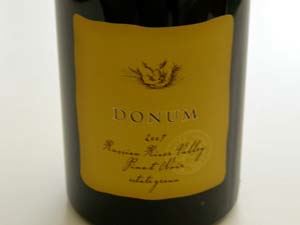 2007 Donum Estate Grown Russian River Valley Pinot Noir 14.4% alc., pH 3.69, 500 cases, $65 (sold out). Blend of Dijon 115 and 667 clones. All free-run juice. Aged 11 months in 75% new Remond French oak. Best barrel selection. Unfined and unfiltered. · Very dark reddish-purple color in the glass. Lovely aromas of Bing cherries, strawberry jam, baking spice, cardamon and clove. Great nose! Delicious and creamy core of cherries and berries nicely enhanced with spice and cola that linger on the generous finish. The glamorous fruit is caressed by supple tannins. I could drink this all night long.
 2007 Donum Estate Grown West Slope Carneros Pinot Noir 14.4% alc., pH 3.72, 150 cases, $70. Inaugural release of this wine. 100% Donum Roederer selection from 4-90 block. De-stemmed, cold-soaked, send to barrel on lees after extended maceration. Aged 16 months in 70% new French oak. Best barrel selection. Unfined and unfiltered. · Hold on to your seat when you pop the cork on this one. Terrific nose that is heavily nuanced with aromas of cherries, berries, spice, oak toast and garden bouquet, all coming and going in the glass over time. The earth-kissed dark stone and berry fruit really attacks the senses and holds on with a firm grip as it coats every nook and cranny in the mouth and lingers for what seems like several minutes. The creamy texture and soft tannins add to the wine’s sensuality. Descriptors don’t do this wine justice. In short, flat-out great.
The Donum Estate wines may be purchased online at www.thedonumestate.com. An Estate Grown Chardonnay is also available. A tasting room is located off site in San Francisco at the Winery Collective at 485 Jefferson Street (415-929-9463). The Donum Estate is not open to the public.
On the Pinot Trail: WOPN 2010The 2010 season of major Pinot Noir events was kicked off in Shell Beach, California on March 5 and 6 with the Tenth Anniversary of the World of Pinot Noir. My report which follows includes coverage of two major seminars and reviews of multiple wines tasted at the event.
 Current William Selyem winemaker, Bob Cabral, and moderator, Michael Jordan, MS, and owner of WORD Wines, kicked off the weekend’s festivities with an unprecedented tasting of Williams Selyem Pinot Noirs released over the period of 1993 to 2005. The tasting was divided into two segments: the “Burt” years (wines from 1991, 1992, 1995, 1996 and 1997 crafted by co-founder of Williams Selyem, Burt Williams) and the “Bob” years (wines from 1999, 2001, 2002, 2004 and 2005 made by Bob Cabral who joined Williams Selyem in July 1998). All the wines came from the library cellars of Williams Selyem guaranteeing their provenance. The two hosts offered many interesting background comments about each wine tasted, accompanied by an extensive photo presentation of the vineyards involved. The only thing missing were Burt and Ed. The Williams Selyem Story has been told many times in the PinotFile, most recently in Volume 8, Issue 11 (www.princeofpinot.com/article/851/). When John Dyson acquired the winery in 1997, some vineyard sources predicated on a handshake agreement were lost (Olivet Lane Vineyard, Rochioli West Block), and new vineyard sources were acquired (Flax Vineyard, Bucher Vineyard, Weir Vineyard, and Peay Vineyard). Olivet Lane Vineyard will be picked up again beginning with the 2009 vintage. Dyson had the financial resources to also acquire land for estate vineyards, something Burt and Ed could never afford. The Drake Estate, consisting of about 35 acres of Pinot Noir and 2 acres of Chardonnay was planted on a property near Guerneville and the first crop was harvested in 2001. A second estate vineyard, the Litton Estate, was planted in 2002 on Westside Road about one mile south of the Allen Ranch where the original Williams Selyem production facility was located. The Litton Estate is 32 acres of Pinot Noir planted to multiple heritage selections and first harvested in 2005. The inaugural bottling of Williams Selyem Litton Estate Pinot Noir received a 100 point score from Wine Enthusiast magazine in 2010. The emphasis at Williams Selyem is on heritage selections, not Dijon clones. The current Williams Selyem customer list has between 35,000 and 40,000 people.
What were Burt’s secrets? First, he was meticulous in his winemaking and kept extensively detailed notes. He attempted to employ the same winemaking techniques for each vineyard which included de-stemming the grape clusters and adding back 20% to 30% whole clusters on the bottom of the fermentation tank, inoculating a Zinfandel yeast acquired from Jackass Vineyard (which is still in use today), employing intense sorting (the initial sorting table was a 4’ x 8’ piece of plywood), avoiding pumping using gravity only or assisted gravity with gas, initiation of hand punch downs with the onset of fermentation, and 5 day cold soaks during which time ice and sulfur dioxide was added to prevent fermentation. Free run juice was sent to barrel, the residual must and juice was bucketed into the press, gently pressed, and added to the top of the barrel. Varying amounts of oak were used depending on the vintage and the wine. All the Williams Selyem wines over the past 30 years have been sourced from vineyards in the Russian River Valley and Sonoma Coast. Jordan pointed out that the Russian River Valley has more soil types than all of France with 400 different soil types in 150 square miles. The earliest documented vineyard in the Russian River Valley was planted in 1839 by Yegor Tschernick. By 1891, there were 300 growers and 7,000 acres of vines. Prohibition and phylloxera killed the wine industry and the region became known for apples, plums and other fruit. Today, there are more than 65 wineries and 13,000 acres planted. The Russian River Valley can be divided into three regions: the Middle Reach which is the most northern area with volcanic ash soils, Green Valley with Goldridge soils, and the Laguna Ridge/Santa Rosa Plain with Goldridge soils along the Laguna Ridge and clay soils on the Plain. The distinguishing climatic feature of the Russian River Valley is the fog which is often termed “heaven’s refrigeration.” It keeps the grapes cool and allows acids to develop. The plentiful daytime sun (it can reach 100 degrees in the summer) creates tannins. The Sonoma Coast is the largest AVA in Sonoma County at 500,000 acres, but it is the least planted area. It has more than twice the annual rainfall of the Russian River Valley, but it is warm enough to ripen wine grapes because the vineyards are located on ridges above the fog line. Because the vineyards are within a few miles of the Pacific Ocean, farming here is literally on the edge and quite risky. There are years, such as in 2005, when some crops were completely damaged, but in the best years, the quality is extraordinary.
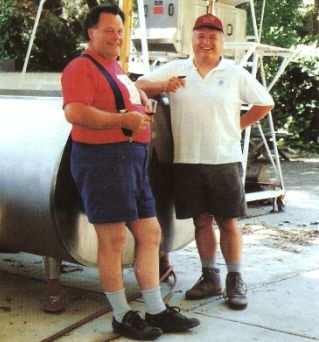 Allen Vineyard Howard and Ann Allen began growing grapes in the Russian River Valley in 1970 on a former prune orchard and pasture along Westside Road. Howard worked with neighbor, Joe Rochioli, and soon was selling grapes to the Allen’s other neighbor, Williams Selyem. The first Williams Selyem Allen Vineyard Pinot Noir was produced in 1980. The Allen Vineyard consists of 14.8 acres of Pinot Noir and 15.63 acres of Chardonnay. The Pinot Noir is an old Pommard selection that is also planted in the West Block and East Block of the Rochioli Vineyard. Some Dijon 115 was added in 2004.
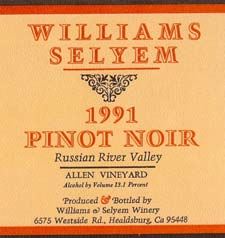 1991 Williams Selyem Allen Vineyard Russian River Valley Pinot Noir 13.1% alc., pH 3.54, 688 cases, $35. Harvested at 22.5 to 23.8 Brix. Aged 16 months in 50% new and 50% 1-year-old Francois Freres oak barrels. · Aromas of green tea, green bean and cherries. Lightly fruited on the palate with notes of strawberries, rhubarb and faint brown spice offset by bright acidity. Oak tannins surfaced as the wine faded over time in the glass.
Olivet Lane Vineyard In 1973, Vincent Pellegrini and his wife Ida bought a 70-acre apple and plum orchard on West Olivet Road in Santa Rosa. They planted Pinot Noir and Chardonnay in 1975, and by the late 1970s, Robert Pellegrini had bottled an “Olivet Lane” Chardonnay and the name stuck. The vineyard consists of 20.1 acres of Pinot Noir and 38 acres of Chardonnay on AXR rootstock. The Pinot Noir clone is reputed to be Martini and the Chardonnay clone Wente. The first Williams Selyem Olivet Lane Vineyard Pinot Noir was produced in 1988.
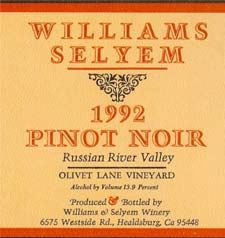 1992 Williams Selyem Olivet Lane Vineyard Russian River Valley Pinot Noir 13.9% alc., pH 3.46, $28. Harvested at 23.9 Brix. Aged 11 months in 62% new and 38% 1- year-old Francois Freres oak barrels. · The nose is remarkably intense featuring black cherries, cola and spice. Richly fruited with amazingly fresh flavors of black cherries and berries. The tannins have fully integrated and the wine drinks like silk. Incredible.
Russian River Valley Blend The first vintage was 1988. Burt’s idea was to try out new vineyards and make a wine for a few years to see if they were worthy of a vineyard designate. This trial developed into the Russian River Valley Blend which has become the winery’s flagship wine. The Drake Estate fruit now makes up over 90% of the blend to ensure a consistent high quality standard. Pommard is the dominant clone in the blend.
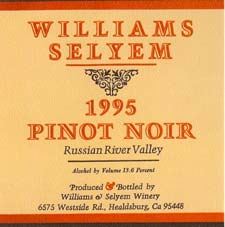 1995 Williams Selyem Russian River Valley Pinot Noir 13.6% alc., pH 3.57, $29. A blend of 27% Olivet Lane Vineyard, 69% Cohn Vineyard, and 6% Rochioli East Block. Harvested at 23.1 to 23.8 Brix. Aged 11 months in 40% new, 30% 1-year-old and 30% 2-year-old Francois Freres oak barrels. · A medium-weighted and well-structured wine with bright black cherry fruit on the nose and palate. The fruit is a little faded bringing acid and oak to the forefront, but there is still plenty of charm.
Hirsch Vineyard This vineyard is located on the true Sonoma Coast at 1,400 foot elevation. Hirsch began planting Riesling in 1980 and was quickly advised to switch to Pinot Noir. Most of the soils are uplifted seabed, gravelly loam with varying degrees of clay. The first vintage for Williams Selyem Hirsch Vineyard Pinot Noir was 1994.
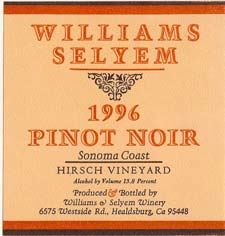 1996 Williams Selyem Hirsch Vineyard Sonoma Coast Pinot Noir 13.8% alc., pH 3.59, $45. Primarily from older blocks planted to Mt. Eden selection and Pommard clone. Harvested at 23.5 to 24.2 Brix in late August as this was a warm year. Aged 18 months in 70% new and 30% 1-year-old Francois Freres oak barrels. · The star of the seminar. Deep and savory berry fruit aromas lead to a delicious and intense berry core that is mildly spiced. Smoothly textured with gossamer tannins and a persistent finish with a slight citrus note. Simply great!
Rochioli Vineyard The story is well known. Seventy-five-year-old Joe Rochioli, Jr., has spent his entire life on the Rochioli Vineyard ranch. Joe was one of the first to realize the potential for Pinot Noir in the Russian River Valley and after several trips to University of California at Davis, found a selection of Pinot Noir in 1967 that would become known as West Block and East Block. The vineyard was initially laid out in a spacing of 8’ by 14’ so that green beans could be inter planted between the vines until they matured to fruit bearing vines. A superb Pinot Noir made in 1972 at Davis Bynum Winery from Rochioli fruit validated Joe’s intuition. 1997 was Burt’s last vintage at Williams Selyem and was the last time West Block fruit was sold to the Williams Selyem winery.
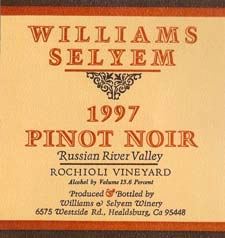 1997 Williams Selyem Rochioli Vineyard Russian River Valley Pinot Noir 13.6% alc., pH 3.53, $125 (Burt requested this price as a tribute to the last vintage of Rochioli Vineyard at Williams Selyem). Harvested at 23.5 Brix. Aged 19 months in 70% new and 30% 1-year-old Francois Freres oak barrels. · Still a big and satisfying wine displaying black cherry and dark red berry fruit with a lush mid palate. Finishes with a note of tart cherries and marzipan.
Bob was approached by Burt about taking over the winemaking reigns. The two of them met in April 1998 to barrel taste at Hartford Court and Burt fed him a steady stream of winemaking questions. The encounter proved mutually satisfying and Bob was offered the job. Bob had only been at Hartford Court for a year and initially declined the offer. Subsequently, he met John Dyson on a trip to the East Coast, and discovered that they shared a common philosophy of winemaking and viticulture. Bob agreed to take the job on one condition: that he would receive one case of each wine produced in every vintage. After John heard this request, there was a long silence and then he broke out in laughter. It was, after all, a very modest request. As a relatively naive 35 year-old, Bob started work on July 29, 1998. Burt had agreed to stay on for 5 years to consult but after the 1998 vintage, he largely left Bob to his own devices. Bob admits that it takes considerable time to understand the vineyards, most critically, when to pick, and initially he leaned on the ripe side. In more recent vintages, he has picked earlier, and the resulting alcohols have moved down into the mid 13s to low 14s. Bob has persevered admirably and today continues to carry forward the tradition of authentic wines established by his predecessor, Burt Williams. Williams Selyem wines are still produced at the leased facility on the Allen property while a new winery and guest center is currently being constructed on the Litton Estate property.
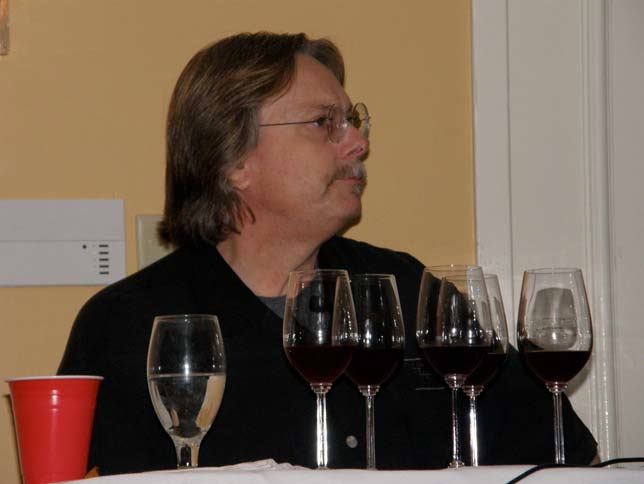 Precious Mountain Vineyard Planted in 1973, the dry farmed Precious Mountain Vineyard is owned and farmed by Donnie and Linden Schatzberg. There are 5+ acres planted to various clones but since 1996, Williams Selyem has used Pommard exclusively. The Pinot Noir is grafted onto Gewürztraminer roots. The organically maintained vineyard is located near Fort Ross, 1,450 feet up on the steep slopes of a former sheep ranch. Precious Mountain has been in partnership with Williams Selyem since 1996, when a chance phone call to Burt Williams created a single contract to sell nearly all their grapes to the winery over the following harvests.
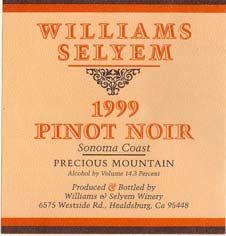 1999 Williams Selyem Precious Mountain Sonoma Coast Pinot Noir 14.3% alc., pH 3.43, $80. Harvested at 24.1 Brix in mid-October during a cold year. Aged 14 months in 66% new and 34% 1-year-old Francois Freres oak barrels. · Astonishingly fresh, as if vinified recently. Vivid plum tart on the nose. Very tasty flavors of Asian spiced plum, wild berries and white pepper. Wines from this vineyard show consistent age ability.
Flax Vineyard This 52-acre ranch was purchased by Phil and Toby Flax in the late 1970s from actor Fred MacMurray. The vineyard sits a little higher on the hillside than the neighboring Allen Vineyard and shares many characteristics of that famous vineyard. Two specific vineyard blocks (6.63 acres) planted in 1996 to Pommard selection are farmed for Williams Selyem by Ulises Valdez. The first vintage for Williams Selyem was 1991 when it was added to the Russian River Valley blend. By 2001, the Flax vineyard had become a vineyard-designate.
 2001 Williams Selyem Flax Vineyard Russian River Valley Pinot Noir 14.3% alc., pH 3.61, $46. Harvested at 23.9-24.1 Brix. Aged 17 months in 60% new and 40% 1- year-old Francois Freres oak barrels. · Bright and nuanced nose showing off scents of raspberries, cranberries, cola and wet wood. Delicious core of moderately rich black cherries and boysenberries with a touch of earthiness and cherry cola. Soft, smooth and very pleasing.
Westside Road Neighbors This blend began as an intellectual exercise proposed by John Dyson. John asked Bob to make a superior blended wine composed of some of the outstanding single vineyard lots. It was meant to be a serious wine, not a mid-tier blend. The initial blend in 2002 turned out to be close to equal parts Bacigalupi Vineyard, Bucher Vineyard, Allen Vineyard, Rochioli Riverblock Vineyard, and Flax Vineyard. Beginning in 2007, a small amount of Litton Estate, located next door to Flax, has been added to the blend.
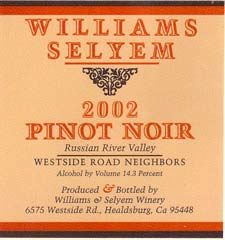 2002 Williams Selyem Westside Road Neighbors Russian River Valley Pinot Noir 14.3% alc., pH 3.55, $59. Harvested at 24.6 average Brix. Aged 15 months in 67% new and 33% 1-year-old Francois Freres oak barrels. · Deeply colored. Perfume of black cherries, ripe strawberries, spice and underbrush which picks up intensity in the glass over time. The flashy attack of raspberry and strawberry is nicely spiced. As the fruit expands in the mouth, the plushness is very sensual. An in-your-face wine that is thoroughly hedonistic with an impressively long finish. Can go many more years.
Rochioli Riverblock Vineyard Rochioli Riverblock was groomed for West Block’s replacement as West Block became infested with numerous diseases and eventually had to be replanted. Riverblock consists of 13 newer acres planted to Dijon 115, 777 and Pommard and 12 older acres planted to Pommard and Wente selection.
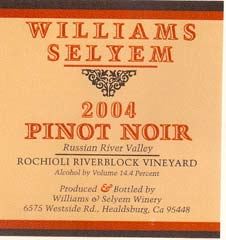 2004 Williams Selyem Rochioli Riverblock Vineyard Russian River Valley Pinot Noir 14.3% alc., pH 3.48, $72. Clones 115, 777 and West Block. Harvested at 24.6 Brix. Aged 16 months in 68% new and 32% 1-year-old Francois Freres oak barrels. · Aromas of spiced berries and cut flowers. Intense and sappy dark red cherries and berries that coat the mouth, finishing with bright aromatic fruit on a very persistent finish.
Litton Estate Vineyard This 51-acre property was acquired by John Dyson in 2001, and was the last large parcel of land available between Rochioli and Davis Bynum on Westside Road. The vineyard is planted to blocks according to soil type with several rootstocks and clonal selections including Pommard, Swan, Mt. Eden, and Calera. A number of horse trades were involved to acquire the desired heritage selections. There is one 3-acre block referred to as Block 10 Mass Selection, where every eighteenth vine is a different clone. The first wine was produced from this vineyard in 2005.
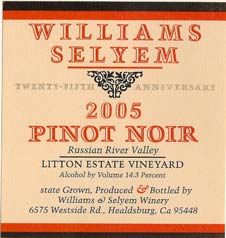 2005 Williams Selyem Litton Estate Vineyard Russian River Valley Pinot Noir 14.3% alc., pH 3.55, 48 cases, $100. Harvested from 12 acres at 24.2 Brix. Pommard (60%), Swan (25%) and Mt. Eden (15%). Aged 18 months in 100% 1-year-old Francois Freres oak barrels. This was the first Williams Selyem 100% estate wine and was given to the winery’s best customers and not sold. · A very pleasing wine that is moderately delicate in style. Lovely aromas of berry tart, cedar and cut flowers. The redder-fruit core is a bit tart and tight. There are some welcoming accents of Asian spice box and cherry cola.
2007 Williams Selyem Litton Estate Vineyard Russian River Valley Pinot Noir This wine was not part of the formal tasting but offered at the end as a special treat. The wine ($100) and the new Reidel Sommelier glass it was served in ($125) made for a very special and expensive treat. · Unfortunately, my new glass apparently came direct from its cardboard container because the cardboard smell ruined the aromatic pleasure of the wine. On the palate, there were waves and layers of fruit including cherries, strawberries and rhubarb with accents of cherry cola, clove and minerals. I hope to sample this wine in the future under more favorable conditions.
Watch the James Beard award-winning video on the Russian River Valley titled Stewards of the Land produced by Grape Radio www.graperadio.com/archives/2008/06/18/graperadio-wines-james-beard-award/. Also, visit the Williams Selyem website at www.williamsselyem.com for more information about the winery and to view additional videos on Burt Williams, Howard Allen and other Russian River Valley winegrowing pioneers.
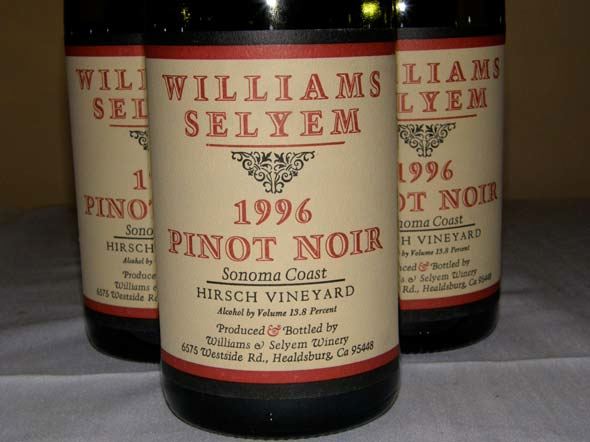
 Allen Meadows, aka Burghound, was the moderator for this seminar featuring the owner and winemaker of Domaine Fourrier, Jean Marie Fourrier. Allen commented during the seminar, “The best wines are built on balance, not concentration,” and the wines of Domaine Fourrier exemplified this. Photo: Meadows left, Fourrier right.
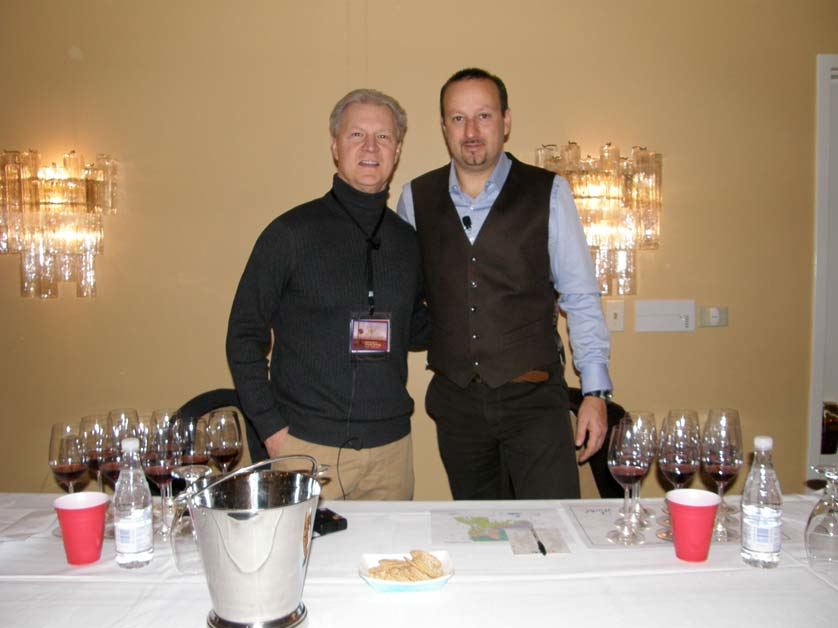 Domaine Fourrier has a four generation history in Gevrey-Chambertain and was one of the first domaines in Burgundy to export wine to the United States. Domaine Fourrier has extensive holdings throughout most of the heralded appellations of Burgundy, but the core vineyards are in Gevrey-Chambertin. The Domaine experienced a revitalization by the arrival of Jean Marie Fourrier in 1994, who combined the traditions of his father and uncle, his experience gained while working with Henri Jayer and Domaine Drouhin Oregon, and his own clear sense of style. Jean Marie inaugurated his own winemaking technique at Domaine Fourrier in 1996, by 1997 he was no longer racking the wines and leaving them in barrel for 18 months. By 1998 he had begun his current technique of de-stemming and natural yeast fermentations. Since Jean Marie assumed the reigns at Domaine Fourrier, the wines have garnered worldwide critical acclaim. Jean Marie puts his ego aside and allows the terroir to speak. His wines are “terroir in a glass.” The wines of Domaine Fourrier are only made from vines at least 30 years old. Selection massale is the single method used to replace failing vines. No chemical fertilizers are used. Every vineyard is vinified separately. Aging is carried out in no more than 20% new oak with the wines left on their lees until bottling which usually occurs 20 to 24 months after harvest. Jean Marie avoids fining and filtering the wines if possible. During the seminar, Allen made several salient comments about the three vintages tasted including 2005, 2006 and 2007. The wines exemplified his summary. The 2005 red Burgundies have power but not currently open for business. They are 20 year wines. Prices are very high. The 2006 red Burgundies have good density and extraction and are 30 year wines. They are more approachable now than the 2005 wines. The 2007 red Burgundies are pure and elegant and the most drinkable now. These are 15 to 17 year wines.
2007 Domaine Fourrier Combe Aux Moines 1er Cru Gevrey-Chambertin Deeply colored. Delicate, shy fruit on the nose. Lovely red and black berry flavors with a hint of dark chocolate. Mild dry tannins and bright acidity. Very approachable now.
2006 Domaine Fourrier Combe Aux Moines 1er Cru Gevrey-Chambertin Dark reddish purple color. Shy aromatics. Richer than the 2007 vintage featuring intense purple fruits and a citrus underpinning. The acidity and tannins are reigned in.
2005 Domaine Fourrier Combe Aux Moines 1er Cru Gevrey-Chambertin A very expressive wine that leaves an impression. Intense black cherry and berry core with hints of oak and orange peel. Smoothly textured, rich and rustic with generous tannin. Needs time but will be spectacular.
2007 Domaine Fourrier Les Champeaux 1er Cru Gevrey-Chambertin Very charming. The nose starts off fruity, later becoming more nuanced with notes of chocolate, toast and oak. Pleasing elegance with balanced tannins. Very tasty with unbelievable persistence. At a little less than $100 a bottle, this is a great Burg to buy and enjoy now.
2006 Domaine Fourrier Les Champeaux 1er Cru Gevrey-Chambertin Compared to the 2007 vintage, rougher, more brooding, more tannic. Slowly opens with air. Massive extraction of mixed berry fruit. Will be great in five to ten years.
2005 Domaine Fourrier Les Champeaux 1er Cru Gevrey-Chambertin Difficult to drink now but the pedigree is evident. Charming black cherry and boysenberry fruit with hints of marzipan and dried cherries. Considerable savory complexion. The prodigious tannin makes the wine chunky and daunting now.
2007 Domaine Fourrier Les Goulots 1er Cru Gevrey-Chambertin Nice finesse and drinkability here. Tasty raspberry, cherry and cranberry fruit with soft tannins and lively acidity on the refreshing finish.
2006 Domaine Fourrier Les Goulots 1er Cru Gevrey-Chambertin Intensely fruity nose that needs time in the glass to open. Pretty core of juicy dark fruits and plenty of firm, dry tannins.
2005 Domaine Fourrier Les Goulots 1er Cru Gevrey-Chambertin This wine has the biggest and most striking nose of any wine in the tasting. Extraordinarily intense ripe dark fruits accented by white pepper and minerals. Less tannin than the 2006 vintage and although showing glimpses of charm, it is currently monolithic and impossible. This will be a prodigious wine in ten to fifteen years.
Unfortunately, finding the Burgundy you want is always a challenge. I would highly recommend you seek out the 2007 Domaine Fourrier wines if you are looking for immediate gratification. If you are willing to wait, look for the 2006 and 2005 vintage wines. Check www.wine-searcher.com, and www.vinquire.com for sources.
 My overall impression this year of the many wines I tasted is that many of them taste the same and lack distinctive characteristics. The overall quality of Pinot Noir from North America continues to shine, but there are many wines that are just ordinary. The bar has been set higher, and producers must challenge themselves to reach for more with Pinot Noir. The wines below are listed in the order they were tasted in the Press Room at WOPN. I have starred the best wines for your quick perusal.
2006 Dukes Family Vineyards Alyssa Willamette Valley Pinot Noir 14.3% alc.. Produced and bottled by Gypsy Dancer Estates. · Initially there is a fecal smell that blows off revealing subtle aromas of berries and herbs. Moderately rich core of cherry and berry fruit with a tart citric edge to the nappy finish. Decent.
2008 Arborbrook Chehalem Mountain Estate 777 Block Pinot Noir 13.6% alc., 400 cases. · Moderately deep reddish-purple color in the glass. Perfume of wooded forest, pine tar and cut flowers. A husky wine featuring purple fruits. A bit flat and linear with grainy tannins and a dry finish. Decent.
2007 William James Cellars Garey Ranch Vineyard Santa Maria Valley Pinot Noir 14.5% alc.. · Aromas of barnyard and oak carry over on the palate. The fruit is very bashful and overwhelmed by oak which dominates the acidic finish. The oak may integrate over time but this wine will always be oaky. Unsatisfactory.
2006 Villa Mt Eden Grand Reserve Bien Nacido Vineyard Santa Maria Valley Pinot Noir 14.2% alc.. · Light reddish-purple color in the glass. Appealing aromas of strawberries, rose petal and sage. Rustic with hi-tone acidity featuring strawberry, cranberry and raspberry fruits. Light and delicate with soft, dry tannins. Decent.
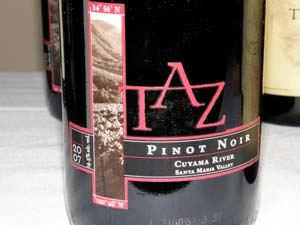 2007 TAZ Cuyama River Santa Maria Valley Pinot Noir 14.5% alc.. · Moderate garnet color in the glass. Very appealing perfume of black cherries, spice and mocha. Soft and velvety on the palate with tasty ripe Pinot fruits set off by brown spices. A bit earthy and briny. Very good.
2007 TAZ Fiddlestix Vineyard Sta. Rita Hills Pinot Noir 14.8% alc.. · Moderately colored with redder tones. Shy nose that picks up interest with time in the glass revealing scents of dark red fruits and toasty oak. Lovely core of smoky dark red cherry and berry fruits with an underlying earthiness. Fairly bold and tannic with more oak than I prefer. Good.
2008 Testarossa Palazzio Central Coast Pinot Noir 14.4% alc.. · Nicely perfumed with lovely rose petal aromas, but he flavors don’t deliver and are tainted by a strong herbal oak edge to the fruit. Soft tannins and a dry finish. Decent.
2007 Three Sticks Durell Vineyard Sonoma Coast Pinot Noir 14.7% alc.. · Moderate reddish-purple color in the glass. Lovely aromas of macerated berries. Darker fruited with an underlying note of underbrush. Very smoothly texture with well proportioned richness. Coats the mouth and leaves a lasting impression. Very good.
2008 Talbott Cuvée Sarah Case Sleepy Hollow Vineyard Santa Lucia Highlands Pinot Noir Named after Robb Talbott’s oldest daughter. Two Dijon clones. · Deep, dark reddish-purple color in the glass. Ripe dark fruits are featured with added flavors of jujubes, cola and raisins. The fruit is slightly roasted. Decent.
2007 Small Vines Russian River Valley Pinot Noir One of the top wines tasted at WOPN - see lead article in Volume 8, Issue 13.
2007 Stephen Ross Stone Corral Vineyard Edna Valley Pinot Noir 15.2% alc.. · Dark in every way from the color to the nose (dark fruits, dark chocolate), to the flavors (black fruits). A big-boned brooding wine with a healthy tannic backbone and some persistence on the fruity finish. The alcohol is daunting, but is wellintegrated. Good.
2007 Lucienne Doctor’s Vineyard Santa Lucia Highlands Pinot Noir 14.8% alc.. · Moderately deep reddish-purple robe in the glass. Very attractive nose replete with spiced berries. An extremely charming wine with the berry fruit core enhanced with notes of spice, cola and chocolate. Discretely rich, beautifully balanced, with an appealing elegance. Very good.
2007 Lachini Vineyards Cuvée Giselle Chehalem Mountain Pinot Noir 14.1% alc.. · This wine has impressive richness of fruit for the 2007 vintage in Oregon but oak dominates the aromas and flavors. Decent.
2007 La Fenetre Le Bon Climat Vineyard Santa Maria Valley Pinot Noir 13.5% alc., 115 cases. · Moderate reddish-purple color in the glass. Well-oaked, shy berry fruit on the nose. A lighter-weight wine with some charming berry fruit. The tannins are reigned in and the wine is easy to drink. Not a revelation, but Good.
2007 Chock Rock Vineyard The Chock Rock Vineyard Monterey County Pinot Noir 14.2% alc.. · The fruit in this wine is overripe and a touch roasted and will appeal to those who like currant and raisin flavors. That said, it is nicely composed and harmonious with supple tannins. Decent.
2008 Clos Martha Marisprach Switzerland Pinot Noir Very light in color. Well-oaked red fruits on the nose. The oak carries through superseding the delicate red fruits. Decent.
2007 Chamisal Vineyards Calita Selection 15.1% alc.. · Very dark, deep color in the glass. A fruit-driven wine with some sweetness and body propelled by the high alcohol. Purple fruited and moderately tannic. Decent.
2007 Kynsi Bien Nacido Vineyard Santa Maria Valley Pinot Noir 13.9% alc.. · Enticing aromas of rose petals and fresh berries. Appealing savoriness on the palate with a smooth texture and impeccable balance. Good.
2008 Gypsy Canyon Trois Sta. Rita Hills Pinot Noir Fruity nose showing off fresh raspberries and blackberries with a touch of spice box. Ripely flavored fruit with accents of Asian spice and anise. Silky, with soft tannins and a dry finish. Good.
2007 Cadre The Architects California Pinot Noir 14.1% alc.. Sourced from four appellations: Laetitia (Arroyo Grande), La Encantada Vineyard (Sta. Rita Hills), Firepeak Vineyard (Edna Valley), and Bien Nacido Vineyard (Santa Maria Valley). This wine has received some very favorable reviews in the wine press but it was to big and ripe for my taste. · Ripe black fruits with a hint of oak and cut flowers on the nose lead to a thick and inky wine on the palate featuring chunky black fruits that are a touch roasted. A good tannic backbone supports the prodigious fruit. Decent.
2007 Bjornstad Hellenthal Vineyard Sonoma Coast Pinot Noir 14.4% alc.. · A bit exotic with aromas of ripe plum, wild berries and toasty oak. Richly fruited and flavorful with husky tannins but with a marvelous velvety texture and a refreshing spark of acidity on the lingering finish. Very good.
2007 Big Basin Vineyards Alfaro Family Vineyard Santa Cruz Mountains Pinot Noir 14.8% alc.. · Nuanced scents of berries, roses and a touch of stem. Alcohol peaks out as the wine sits in the glass. Ripe fruit flavors with a roasted and green bean note. The tannins are supple making the wine easily drinkable. Decent.
2008 Asuncion Ridge Vineyards San Luis Obispo County Pinot Noir 14.4% alc.. · Very pretty aromatics featuring black cherry and mixed berry fruit with roseate notes. Discretely concentrated core of black raspberry fruit set off by accents of cola and coffee bean. Beautifully composed with supple tannins and respectable persistence on the aromatic finish. I like this. Very good.
2004 Talisman Red Dog Vineyard Sonoma Mountain Pinot Noir 14.1% alc.. Talisman always pours wines which are a vintage or two behind others. · Deep, dark reddish-purple color in the glass. Aromas of sweet, ripe plums and sugared berries. A masculine, muscular wine featuring ripe dark fruits, moderate tannins and an earth-toned fruity finish. This wine has many years ahead of it. Very good.
2007 Perception Russian River Valley Pinot Noir 13.8% alc.. · Ripe dark berries are the featured fruit in this wine veering toward raisiny flavors. Hard to recognize as Russian River Valley. Moderately grainy, dry tannins. May have been watered back to reach the low alcohol. Decent.
2008 Red Car Trolley Sonoma Coast Pinot Noir 14.5% alc.. · Muted aromas of berry fruit. Linear and simple flavors of mixed berries and underbrush. Just can find anything interesting in this wine. Decent.
2007 Roar Garys’ Vineyard Santa Lucia Highlands Pinot Noir 13.8% alc.. · A very impressive wine that breaks the mold of high extraction typical of the Roar style. Nicely perfumed with black cherries and blackberry fruit. Very sensual and understated on the palate with appealing flavors of spiced berries set off by gossamer tannins and proportioned acidity. One of the best wines tasted at WOPN. Very good.
2007 Drangonette Cellars Santa Rita Hills Pinot Noir 14.1% alc., 100 cases. · A direct and tasty wine featuring a melange of berries and a hint of citrus on the refreshing finish. Soft in the mouth, discreetly weighted, and easy to drink. Good.
2007 Lucia Garys’ Vineyard Santa Lucia Highlands Pinot Noir 14.5% alc.. · The aromas are primarily oakderived showing roasted coffee and dark chocolate. Darkly fruity and chunky, a bit rustic, with a prominent chocolate flavor that should appeal to many. Has healthy tannins to stand up to hearty fare. Good.
2007 Hartford Court Arrendell Vineyard Russian River Valley Pinot Noir 14.3% alc.. · Deep, dark reddishpurple color in the glass. Love the nose and keep going back. Vivid and penetrating dark Pinot fruits with a little oak riff. Luscious plum and deep berry fruit with a slight sweetness. Flavors of oak, tar and smoke add interest. Smooth in the mouth with a slight watered-down tone on the finish which leaves a little heat in its wake. Good.
2008 Freeman Russian River Valley Pinot Noir 14.2% alc.. · Demure aromas of red cherries and berries. Soft in the mouth with charming flavors of cherries and cherry cola. Oak is still prominent and may integrate over time. Good.
 2007 RN Estate Fiddlestix Vineyard Santa Rita Hills Pinot Noir 14.4% alc., 120 cases. · A chameleon in the glass starting off with aromas of cherries, summer herbs including sage, and oak ramping up in fruit intensity with notes of good barnyard. Soft and delicate in the mouth but possessing a richly flavored core of cherry and berry fruit. A tame style of Fiddlestix with very supple tannins. This wine seduces more than it attacks. Very good.
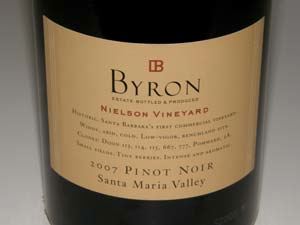 2007 Byron Nielson Vineyard Santa Maria Valley Pinot Noir 14.6% alc.. The Nielson Vineyard was planted in 1964 by Uriel Nielson, the first commercial vineyard in Santa Barbara County. The site is windy, arid and cold leading to low vigor vine growth. Clones 113, 114, 115, 667, 777, 2A and Pommard. · Darkly colored. Intensely fruity nose featuring dark berries with a hint of oak toast, oak spice and sandalwood. Impressive explosion of fruit on the nose. Over time in the glass, aromas of underbrush and brininess that is common in the Santa Maria Valley Pinot Noir fruit emerges. Plenty of pleasing red and black fruits on the palate with a sidecar of earth, tea and spice. A Caliesque-styled wine that provides plenty of pleasure at a decent price. Perfect with a grilled steak. Very good.
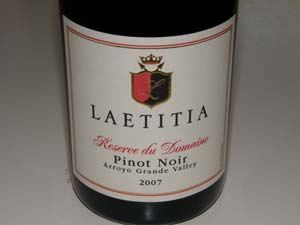 2007 Laetitia Reserve du Domaine Arroyo Grande Valley Pinot Noir 14.1% alc.. A barrel selection, estate grown, bottled and produced at Laetitia. From a cool site 3 miles from the Pacific Ocean that is sustainably farmed. Clones 115, 667, 459, 2A, Pommard 5, and Martini B. Aged 11 months in 40% new and 60% neutral oak barrels. Eric Hickey is the winemaker. · Dark reddishpurple color in the glass. Very appealing aromatics offering black cherries, strawberries, spice, rose petals and a little ocean air. Luscious core of dark berries and strawberries with hints of earthy loam and cola. Rich and full-bodied but retains a charming appeal. Mild tannins make for easy drinking. A bold wine that makes a statement and attracks your attention. Very good.
2007 Flowers Sonoma Coast Pinot Noir 13.4% alc.. · Lightly colored with red tones. Scents of strawberries, cherries, baking spices and a hint of oak char. On the lean side with redder fruits set off by an appealing minerality and grassiness. The tannins are reigned in and the hi-strung finish features tart cherry and cranberry flavors. Considering the vintage and the reputation of this superb winery, this wine is a bit disappointing. Nevertheless it is Good.
On The Pinot Trail: Pigs & PinotThe Fifth Annual Pigs & Pinot Celebration was held March 19 and 20, 2010 at Hotel Healdsburg in Healdsburg, California. This event has become more popular every year, and tickets sold out within 15 minutes after they were made available for purchase on the internet. The allure of the event is the bringing together of the country’s most prolific pork and wine professionals, and many of the world’s best Pinot Noirs. The guest chefs included Bryan Voltaggio (VOLT Restaurant, Frederick, Maryland), Kevin Gillespie (Woodfire Grill, Atlanta, Georgia), Tyler Florence (Tyler Florence Rotisserie & Wine, Mill Valley, California), all prominent luminaries on the Food Network, and noted San Francisco restaurateur and James Beard Award for Best Chef in California winner Roland Passot (La Folie, Left Bank and LB Steak). Visiting chefs included Dustin Valette (Dry Creek Kitchen, Healdsburg), Amar Santana (Charlie Palmer at Bloomingdale’s), Scott Romano (Charlie Palmer at The Joule), Matt Hill (Charlie Palmer Steak, Washington DC), Tony Aiazzi (former Aureole Executive Chef), and Phillippe Rispoli (Supreme Cuisine). Kevin Gillespie (left) and Amar Santana are pictured below at the event. The guest winery representatives were Paul Hobbs (Paul Hobbs Winery), Michael Browne (Kosta Browne), Tony Soter (Soter Vineyards), Ben Papapietro (Papapietro Perry), and Suzan Chambers (importer of wines of Domaine de l’Arlot of Burgundy).
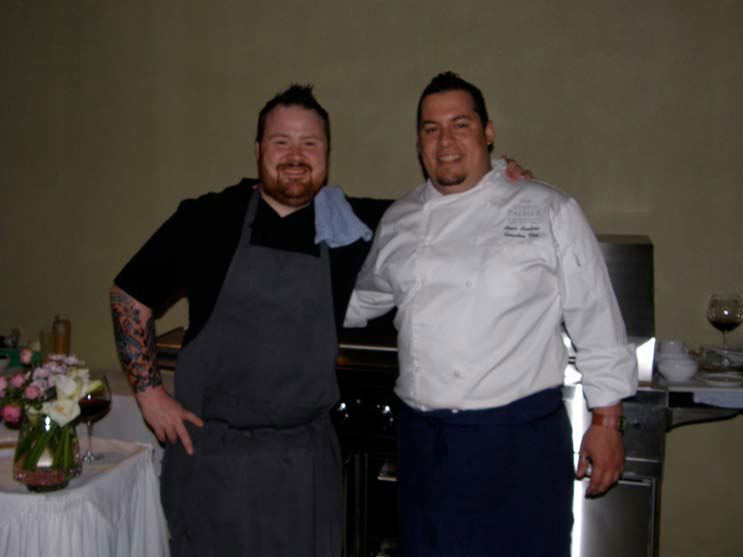 The weekend benefits Share Our Strength®, the nation’s leading nonprofit organization working to end childhood hunger in America by 2015 (nearly one in four children in the United States currently struggle with hunger), the Healdsburg Education Foundation, St. John School, and The Healdsburg School. For this year’s gala dinner, two suckling pigs were raised, hand-picked from Clark Summit Farm and raised in the gardens of Quivira Vineyards. The pigs were fed Dry Creek Kitchen Restaurant vegetable scraps and finished in the European style, with an acorn diet to produce a richer marbling and slightly sweet fat. The driving force behind the Pigs & Pinot event is Charlie Palmer of the Charlie Palmer Group. A celebrated chef and hospitality entrepreneur, Charlie Palmer has been acclaimed for his progressive American cooking infused with classical French cuisine. In 1988, he first achieved notoriety while creating dishes featuring regional American ingredients at his restaurant, Aureole, which relocated to a new location at One Bryant Park in 2009. Over the years, Palmer has opened 13 notable restaurants across the country, a growing number of wine shops and exceptional boutique hotels. Palmer is the author of four cookbooks including Charlie Palmer’s Practical Guide to the New American Kitchen (Mecher Media/2009). Palmer is a long time Burgundy devotee, but he only fully embraced the Pinot Noir grape when he moved from New York to Healdsburg. He is now a “drink local” guy who loves to showcase his favorite Sonoma County wines at Dry Creek Kitchen.
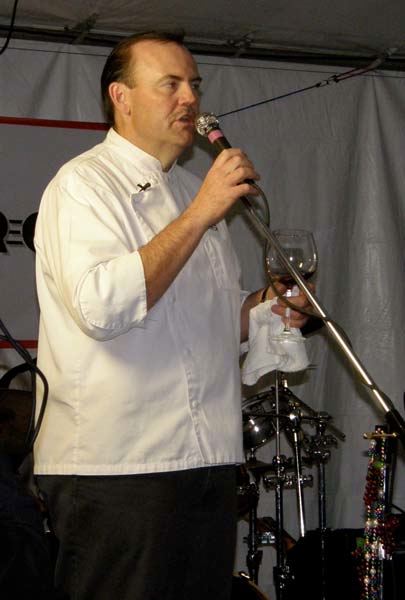 I participated as one of three judges in the event’s Pinot Cup. Ray Isle, Wine Editor of Food & Wine and Virginie Boone, contributing wine writer for The Press Democrat, joined me on Friday afternoon as we blind judged 51 Pinot Noirs from California, Oregon, Burgundy, South Africa and New Zealand. The list of producers read like a who’s who of Pinot Noir and it was quite a challenge for us to pick the best wine and a runner up.
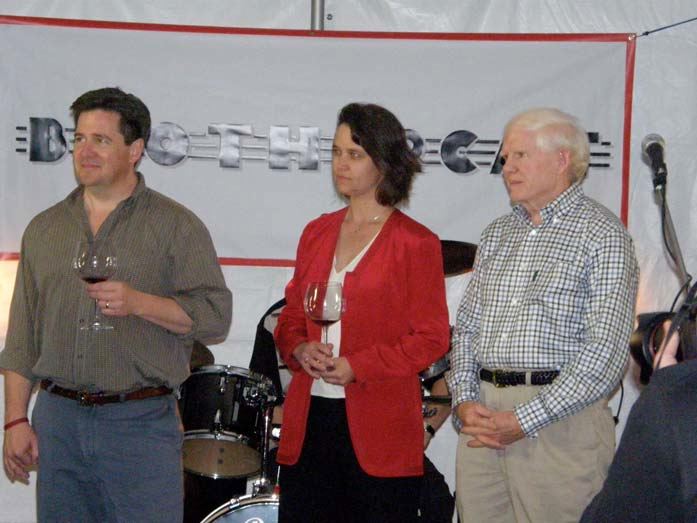 The winning wine was an unanimous pick, however: 2007 Woodenhead Buena Tierra Vineyard Russian River Valley Pinot Noir. The runner up was: 2007 Williams Selyem Westside Road Neighbors Russian River Valley Pinot Noir. The photo below shows the ebullient owners of Woodenhead, Zina Bower, who handles marketing and sales, and Nikolai Stez, the winemaker. Nikolai owes his inspiration to Burt Williams of Williams Selyem. He worked seventeen harvests at Williams Selyem as an assistant winemaker to Burt, learning from the master. With the sale of Williams Selyem in 1997, Nicolai started his own label, Woodenhead. Winemaking is “Burgundian done in the California style.” I have been a fan of Woodenhead Pinot Noirs since 2004 and was happy to see the much-deserved award go to Woodenhead. Consider visiting the Woodenhead Tasting Room, recently voted Best in Sonoma County by readers of Bohemian magazine. The tasting room is open Thursday through Monday from 10:30 to 4:30 and is located at 5700 River Road, one mile west of Slusser, in Santa Rosa. The website is www.woodenheadwine.com.
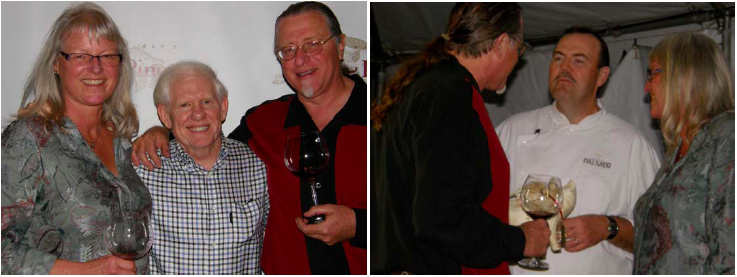 The Buena Tierra Vineyard was planted in 1978, making it one of the oldest vineyards in the Russian River Valley. Owned and farmed by Joseph R. Miller, this venerable vineyard is located 1.5 miles southeast of Rochioli Vineyard in the low hills of the Laguna Ridge where the Russian River turns to head west to the Pacific Ocean. The site is ideal for Pinot Noir and Chardonnay, with well-drained sandy clay loam soil, cooling morning and evening fog, and bright sunshine during the day. Selectively irrigated, the vineyard is planted to several clones. Unfortunately, the vineyard is showing its age and yields are very small. Miller continues to farm the vineyard solely out of love for the wines that it produces since it is not at all profitable. Through the years, the vineyard has been the source of grapes for many notable bottlings including those of Williams Selyem and the now defunct Seven Lions Winery (owned by deceased Fred Williams). Since the sale of Williams Selyem in 1997, former Williams Selyem alumni Margi Wierenga (Brogan Cellars) and Nikolai Stez have been major recipients of Pinot Noir grapes from Buena Tierra and both produce vineyard designates using grapes from the original plantings. The Chardonnays have been impressive as well from this vineyard (Alban, Keegan Cellars, Shibumi Knoll, and Turjanis). I did not keep detailed tasting notes but there were several other wines in the Pinot Cup that impressed me: 2006 Wild Horse Cheval Sauvage Santa Maria Valley Pinot Noir, 2007 Soter Vineyards Mineral Springs Ranch Willamette Valley Pinot Noir (the 2006 and 2008 vintages were also tasted at the Gala Dinner and all three vintages are superb), 2007 Alysian Rochioli Vineyard Allen-Rochioli Blocks Russian River Valley Pinot Noir, 2007 Arista Perli Vineyard Mendocino Ridge Pinot Noir, 2007 MacMurray Ranch Winemaker’s Block Selection Russian River Valley Pinot Noir, 2007 george Ceremonial Vineyard Russian River Valley Pinot Noir, 2008 Thomas George Estates Lancel Creek Vineyard Russian River Valley Pinot Noir, 2008 Selby Calegari Vineyard Russian River Vally Pinot Noir, and 2008 De La Montanya Tinas Vineyard Russian River Valley Pinot Noir. Other Pinot Noirs sampled during the weekend which I can highly recommend include: 2007 Domaine Dujac Gevrey-Chambertin, 1er Cru, Burgundy, 2008 Penner-Ash Dussin Vineyard Yamhill-Carlton District Willamette Valley Pinot Noir, 2007 Woodenhead Humboldt County Pinot Noir and 2006 Peay Vineyards Pomarium Estate Sonoma Coast Pinot Noir. The event wrapped up on Saturday evening with a Gala Dinner at the Dry Creek Kitchen. If you were lying in bed for hours and dreaming of the perfect dinner cooked by some of our country’s greatest chefs and accompanied by a lineup of superb Pinot Noirs, you could not top this dinner. I have included a copy of the menu below for you to drool on.
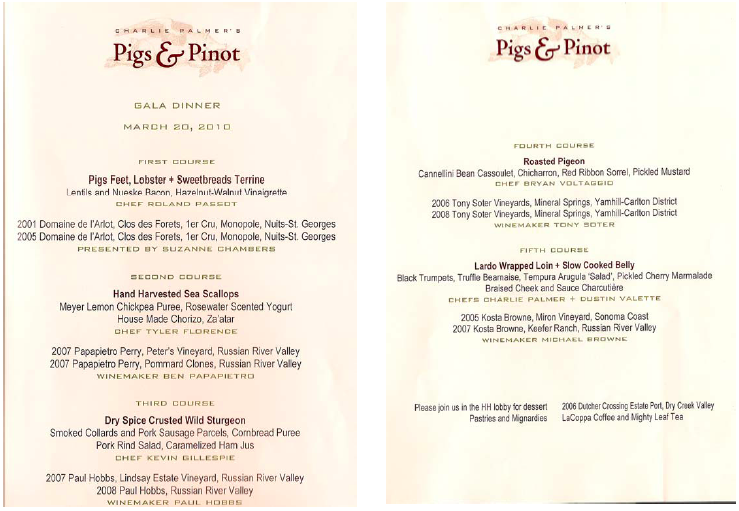 If you want to organize your own Pigs & Pinot dinner, consider using these pork product suppliers recommended by Charlie Palmer: Surry Farms, Virginia: Local Serrano-style ham. Cure master Sam Edwards uses 100% pasture-raised, certified humane heritage Berkshire hogs, each fed two pounds of Virginia peanuts per day to create meat with serious marbling. Extended aging time creates a richer, concentrated flavor with overtones of salt and smoke. www.surryfarms.com. La Place, Louisiana: Authentic Cajun Andouille sausage. Authentic pecan wood-smoked Andouille. You can’t cook Cajun without it. www.cajunsausage.com. Salumeria Biellese, New Work City: Old World style Italian salami. Since 1925, Salumeria Biellese has been making salami the old-fashioned way: slowly and with great attention to detail. Using only Berkshire pork, they employ the same painstaking methods in all their selections from salame Biellese which is mildly spicy in classic Piedmontese style, and the meaty, robust Cacciatorini or “hunter’s style” salame. Think of it as Italian jerky. www.salumeriabiellese.com. Benton’s Smoky Mountain Country Hams, Knoxville, Tennessee: Hickory smoked bacon. Allan Benton has become the bacon maker to the stars and considered by many chefs to be the best bacon smoker in the country. He turns out traditional dry-cured bacon that’s hand-trimmed for optimal meat-to-fat ratio with a perfect confluence of salty-smoky-brown sugar sweetness. www.bentonshams.com. Knight Salumi Co, San Diego, California: Rey Knight crafts handmade artisan salumi using locally raised chemical free cured meats and organic spices in an inspired Italian style. Examples include Cacciatori, the traditional Lombardy regional specialty seasoned with garlic, Chianti and black pepper, to Coppa Molina Salami, using the upper collar of the Hog, spiced and cured before being coarse ground and then aged. www.knightsalumico.com.
Freeman Winery: Tasting the 08’sKen likes to tell the story about how he met his wife, Akiko, who is his partner in the Freeman Vineyard & Winery. After college, Ken was sailing on a boat to the Caribbean with a friend, but Hurricane Gloria forced them ashore in Larchmont, New York, close to Ken’s hometown. Ken decided to visit and joined a party where he met Akiko, who had recently arrived from Japan and shared his passion for fine wine, especially Pinot Noir. The date of their meeting, September 26, 1985, is engraved on the keystone at the winery’s entrance. The Freemans launched their winery in 2001 after acquiring a small winery in the Russian River Valley town of Sebastopol. From the beginning, they were committed to a style of Pinot Noir that featured elegance, lovely ripe fruit flavors, and approachability upon release, yet possessed enough depth and structure for extended aging. Freeman wines are sourced from 13 different vineyards in the Sonoma Coast and Russian River Valley appellations. The 6-acre Guidici Vineyard, high above the town of Occidental, owned by Leonard and Geri Guidici and farmed by Charlie Chenoweth, has been a source of grapes for Freeman for the last five years. Next to the Guidici Vineyard, the Freemans have planted 12 acres of Pinot Noir at what is called Freeman Ranch Vineyard. The clonal mix includes 667, 2A, Pommard, and Swan, Calera and La Tache selections. Except for the Keefer Ranch vineyard designate bottling, all the Freeman wines represent blends from various vineyards. The winemaker since the winery’s beginning has been Ed Kurtzman, a likable, laid back but extremely talented vintner, who also crafts wine for August West, Roar and Sandler Wine Company. Akiko and Ken are also involved in the winemaking and participate in all the blending and stylistic decisions. The Freeman winery is unique in the Russian River Valley, housed in a cave which has been beautifully refurbished by the Freemans. The 2008 wines are the best I have tasted from Freeman to date. The 2009s, tasted out of barrel are precocious and astonishingly good. As much as the 2007 vintage has been touted in California, many winemakers feel that the 2008 vintage wines are every bit as good and the 2009 wines will possibly exceed them both in quality. The Freeman 2008 vintage wines have just been released.
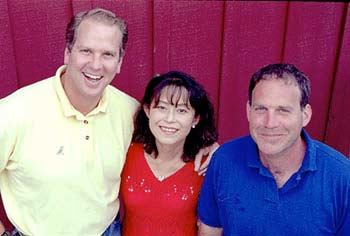
2008 Freeman Vineyard & Winery Russian River Valley Pinot Noir 1,473 cases, $44. Sourced from five vineyards, with a third from Ted Klopp’s Thorn Ridge Vineyard. Aged 11 months in 47% new French oak. · Richer and earthier than the Sonoma Coast bottling with bright flavors of ripe Bing cherries, dark berries, oak and cola. Still rather closed but the future is very promising for this wine. Has the bones (tannins and acidity) to age ten years. Good.
2008 Freeman Vineyard & Winery Ryo-Fu Russian River Valley Chardonnay 14.1% alc., 550 cases, $44. Sourced from Heintz Vineyard, Keefer Ranch and Black Emerald Vineyard. Aged 14 months in 20% new French oak, barrel fermented with 100% MLF. · Beautifully proportioned with just the right touch of oak. Crisp and clean with appealing flavors of pear, white peach and creme brulee. Not at all tiring to drink like many California Chardonnays. One of the top California Chardonnays I have tasted from this vintage. Very good.
2008 Freeman Vineyard & Winery Sonoma Coast Pinot Noir 1425 cases, $44. 44% Rayhill Vineyard, 32% Guidici Vineyard, 24% Sexton Vineyard. Aged 11 months in 40% new French oak. · Very approachable wine that is medium-weighted with charming black cherry fruit and soft tannins. The nose is quite delicately fruited with notes of dried rose petals. I liked this a lot. Very good.
2008 Freeman Vineyard & Winery Keefer Ranch Russian River Valley Pinot Noir 14.2% alc., 445 cases, $48. Aged 11 months in 35% new French oak. · Bright scents of strawberry and raspberry tart with hints of baking spice and orange tea. Tasty panoply of redder fruits with herbs and tea leaves mixed in. Silky smooth with soft tannins, bright acidity and an appealing elegance. A sweetheart wine that is very approachable now and quite easy to drink. Very good.
2008 Freeman Vineyard & Winery Akiko’s Cuvée Sonoma Coast Pinot Noir 14.2% alc., 420 cases, $56. A barrel selection chosen by Akiko, Ken, and winemakers Ed Kurtzman and Eric Buffington. Each person’s top barrels are blended and tasted blind. Called Akiko’s Cuvée, because her blend nearly always wins this blind tasting. Keefer Ranch fruit makes up the largest portion. Aged 11 months in 38% new French oak. · Shy, teasing aromatics with scents of wild berries, oak toast and cut flowers. Rich and satisfying red and purple fruits on the palate with caressing tannins. Very smoothly textured and seamless. Tasted the next day and the day after from a previously opened and re-corked bottle, the wine retained its appeal indicating age ability. A stunning wine that will easily go 15 years. My wife went gaga over this wine.
Production at Freeman Vineyard & Winery is about 4,000 cases annually and most of it is sold through a customer list at www.freemanwinery.com.
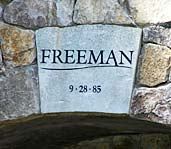
Kosta Browne: Tasting the 08’sNow that the 2008 vintage has been in bottle three months, Michael Browne is very pleased with the wines. Wedged between the spectacular 2007 and 2009 vintages, the 2008 vintage wines can be overlooked but should not be sold short. Some of the 2008 Kosta Browne bottlings, such as the Rosella’s Vineyard, are better than the 2007 versions. Check out this very cool tasting bar in the Kosta Browne barrel room made of stainless steel fashioned as a cut off wine tank.
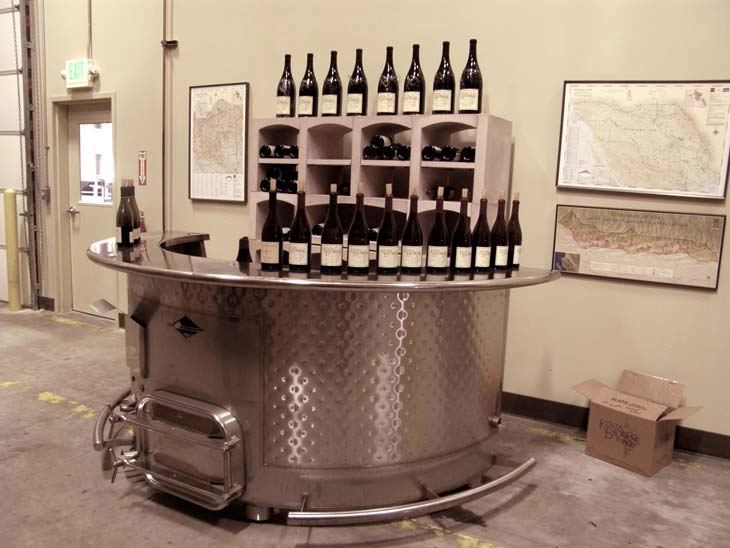 Michael was kind enough to open a bottle of every wine produced by Kosta Browne in 2008. If you are a fan of the Kosta Browne style - deep color, moderately high alcohols, vibrant aromatics, and ripe, opulent fruit, you will be seduced by these spectacular wines. As good as these wines were in March, they will be irresistible come fall when most of them are released after another six months of bottle age. Grapes are harvested relatively ripe, and de-stemmed. Some 100% whole cluster barrels are vinified separately to be added back if deemed appropriate for the vintage and the wine. A 5-day cold soak is followed by inoculated fermentations lasting 9 days on average with 1 to 2 punch downs per day in 1-ton and 5-ton open top stainless steel and wood vessels, and barrel aged for 16 months. The amount of new French oak will vary depending on the vintage and vineyard source but is usually between 38% and 45%. Excellent barrels from eight different coopers are used even for the appellation wines. Kosta Browne wines are sourced from the Russian River Valley, Sonoma Coast and Santa Lucia Highlands. The 2008 Kosta Browne Sonoma Coast and Russian River Valley appellation bottlings were recently released and are sold out. The wines are still available on the secondary and retail market, but at a premium (often a significant markup over the release price). The vineyard-designates and 4-Barrel will be released in the fall of 2010. Michael is crafting Kosta Browne Chardonnay beginning with the 2009 vintage. Assistant winemaker, Shane Finley, joined us in the tasting and I briefly sampled his four 2008 Pinot Noir releases produced under his SPELL label. These wines will be reviewed in more detail in a subsequent issue. Michael was his usually animated self behind the bar as he poured the Kosta Browne lineup. Unfortunately, he kicked his leg back in a moment of revelry and a 6L bottle of 2006 Kosta Browne Russian River Valley Pinot Noir sitting on a shelf behind him struck the floor and broke off at the neck sending of flood of Pinot onto the floor. Large formats of Kosta Browne wines are kept for charity donations and never sold. Last year a similar 6L bottle was auctioned at a charity event for $20,000. Never one to cry over spilled wine, Michael shrugged it off, chalked it up to an angel’s share and we all enjoyed a satisfying pour.
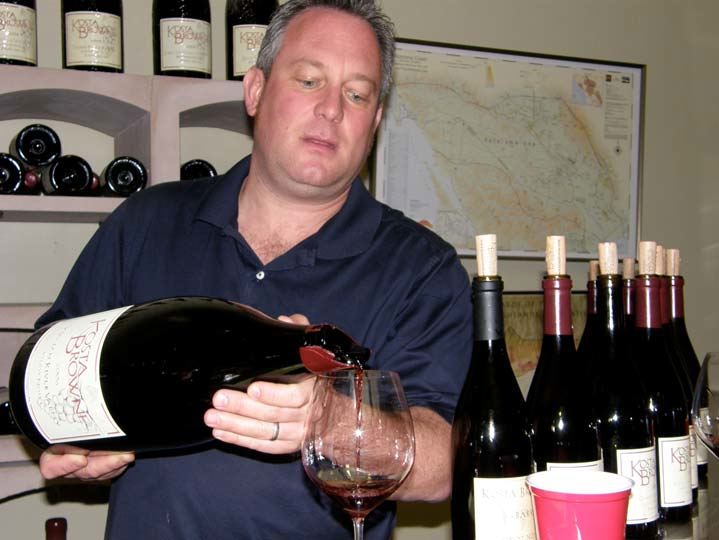 The 2008 Kosta Browne Pinot Noirs are still babies and will require additional time in bottle for full enjoyment. That said, several of them are very charming now.
 2008 Kosta Browne 4-Barrel California Pinot Noir 14.9% alc.. This wine changes every year. In 2008 it consists of one barrel of Koplen 667, one barrel of Amber Ridge 667, one barrel of Garys’, and one barrel of Kanzler 666 whole cluster. · A stunning wine showing aromas of black raspberries, dark strawberries and mocha. Flat-out delicious with a velvety mouth feel that is very sensual. Still a Lolita, but give this a couple years in the cellar and you will have a drinking experience you can tell your grandchildren about. Very good (+).
2008 Kosta Browne Amber Ridge Vineyard Russian River Valley Pinot Noir 14.7% alc.. · This wine is showing plenty of oak at present and will need time. Darker Pinot fruits are featured with savory and earthy underpinnings. Good.
2008 Kosta Browne Gap’s Crown Vineyard Sonoma Coast Pinot Noir 14.8% alc.. Dijon clones and Swan selection. · Big and luscious, with prodigious purple fruits wrapped in fine-grain tannins. Still has tannins to shed, but will offer a decadent drinking experience. Good.
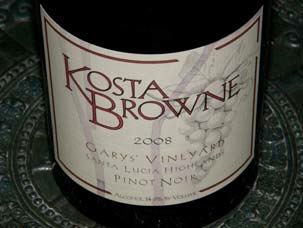 2008 Kosta Browne Garys’ Vineyard Santa Lucia Highlands Pinot Noir 14.9% alc.. · Always an impressive wine from KB. Perfume of spice plums and violets lead to a concentrated attack of black cherries and boysenberries accented with flavors of baking spices and sandalwood. A very charming wine that I find irresistible. Very good (+).
2008 Kosta Browne Kanzler Vineyard Sonoma Coast Pinot Noir 14.7% alc.. · Strikingly floral on the nose showing scents of lavender and violets. Bright and juicy red and black fruits, nicely spiced, with nuanced flavors of cola, tea and earth. A charmer whose soft tannins make it hard to resist now. Very good (+).
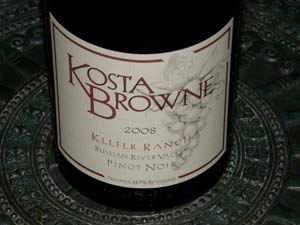 2008 Kosta Browne Keefer Ranch Russian River Valley Pinot Noir 14.7% alc.. · Redder fruit profile with a melange of spices. A pretty wine with soft tannins and a smooth finish. Very approachable now. Always the most feminine wine in the KB lineup. Very good (+).
2008 Kosta Browne Koplen Vineyard Russian River Valley Pinot Noir 14.8% alc.. Clone 667. 25% whole cluster. · A very attractive wine with pretty scents of black raspberries, spice box and roses. Rich and big-boned, yet very smooth on the palate. Very good.
2008 Kosta Browne Pisoni Vineyard Santa Lucia Highlands Pinot Noir 14.8% alc.. · Mouth coating black fruits with an oaky and meaty edge. Potently fruity, but not over the top. Will need time to integrate the oak and tannins. Very good.
2008 Kosta Browne Rosella’s Vineyard Santa Lucia Highlands Pinot Noir 14.5% alc.. · Striking expression of fresh red and black berry fruit. The tannins are reigned in, the texture is silky, and the fruity finish is expansive. Very good (+) and the most exceptional offering I have had from this vineyard by KB.
2008 Kosta Browne Russian River Valley Pinot Noir 14.7% alc.,pH 3.67, $52. Sourced from seven vineyards. 5 day cold soak, aged 16 months in 44% new French oak. · Appealing scent of crushed berries, spice box and cut flowers. A juicy wine sporting flavors of dark cherries and berries, cola and savory herbs caressed by soft tannins and offering a creamy texture. Very good.
2008 Kosta Browne Sonoma Coast Pinot Noir 14.6% alc., pH 3.66, $52. From Gap’s Crown, Terra de Promissio and Walala vineyards. Aged 16 months in 44% new French oak. · Lovely aromas of dark stone fruits and dark chocolate which carry over in the flavor profile. Well-structured with notable tannin, this wine should soften and integrate beautifully over time. Very good.
The 10,500 case production of Kosta Browne is sold through a faithful mailing list which is regrettably full. Visit the website to sign up for the waiting list at www.kostabrowne.com. The winery is not open to the public, but the winery participates in practically every major Pinot Noir festival as well as many other wine events and charitable auctions around the country. The wines are often sold on the secondary market through auction sites such as www.winecommune.com.
Siduri Wines: Something for EveryoneAdam and Dianna Lee travel the states of California and Oregon sourcing grapes for their many offerings of Pinot Noir (17 different Pinot Noirs in the 2007 vintage). Their winery, Siduri Wines, has the distinction of producing more distinct Pinot Noir bottlings than any other producer in California. Since beginning modestly in 1994, the Lees have found an increasing and changing number of outstanding vineyard sources for Pinot Noir stretching all the way from Oregon’s Chehalem Mountains in the northern Willamette Valley to the Sta. Rita Hills in California’s southern Central Coast. As if that wasn’t enough to shoulder, in 1998, they began producing Syrah and other varietals under the Novy Family Wines label, named after Dianna’s family, the Novys. Siduri is the Babylonian Goddess of wine and beer, merry making, and wisdom. She is referred to in The Epic of Gilgamesh as “the girl whose drinks refresh the soul.” It seemed only appropriate that Pinot Noir enthusiasts, Adam and Dianna, would stumble across the goddess in a wine book written by Hugh Johnson, and adopt her name for their winery. The Lees have remarked, “We thought it was about time that someone other than Bacchus got some credit for wine.” The Siduri label says, “Beside the sea she lives, the woman of the vine, the maker of the wine.” The Lees hail from Texas, and when they arrived in Sonoma County in 1993, they had no winemaking experience. Adam, like many of his winemaker brethren, followed a circuitous route to winemaking. He majored in history in college where he had his first drink. He had been raised in a Southern Baptist family that disapproved of drinking alcohol. Fresh out of school, the only employment he could find was in a wine store. It was a serendipitous job, for Adam was able to taste many of the great wines of the world. He had a knack for selling wine and rose to President of Austin Wine & Spirits, before becoming a buyer for Nieman Marcus in Dallas, where he met Dianna. Dianna grew up on a farm and majored in marketing in college, both pursuits that eventually would provide a valuable background for the wine business that was to come. The couple began with $24,000 and one acre of Pinot Noir from a vineyard in the Anderson Valley, producing 107 cases of their first vintage in 1994, shortly after their engagement. On a whim, they left a bottle of their first Pinot Noir with Robert Parker, Jr., who was staying at the Meadowood Resort in the Napa Valley. Parker would give the wine a high score and they were in business to stay. Their rise to success was meteoric. Critics fawned over the winery’s first releases and noted wine critics like Robert Parker, Jr. (“One of California’s top Pinot Noir producers”), and Matt Kramer (“To taste Siduri is to taste some of the best Pinot Noir made in America today”) were effusive. Despite their notoriety, the Lees have worked out of a modest winery warehouse in an industrial park in Santa Rosa since 1998. It is a no frills operation where the emphasis is on the wines. Both Adam and Dianna are intimately involved in the production of every wine. Ryan Zepaltas is the assistant winemaker.
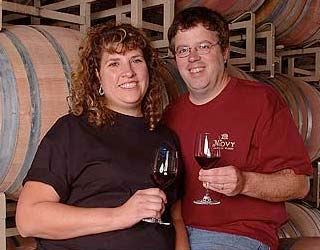 Siduri has always been committed to quality. Grapes are purchased by the acre and crops are rigorously thinned. All work in the winery is hands on with a commitment to top quality oak, and all wines are bottled unfined and unfiltered when possible. The Pinot Noirs have been full-bodied, fruit-driven and very Caliesque in style, yet balanced and consistently reflective of the vineyard sources and vintages. The logistics of producing so many individual wines is daunting and occasionally a wine misses the mark, but the majority of Siduri’s production is top rate. The Lees have always been sensitive to pricing and have raised their prices little over the years. They offer something at every price range (under $20 to $70) among the 7,500+ cases of wine they produce annually. The appellation bottlings are a particularly good value and offer the consumer an opportunity to taste representative wines from multiple appellations to compare the characteristics of wines from the different regions. Appellation bottlings are available from Chehalem Mountains, Sonoma Coast, Russian River Valley, Santa Lucia Highlands and Sta. Rita Hills. Vineyard-designate Pinot Noirs are sourced from some of California’s finest vineyards including Clos Pepe Vineyard, Cargasacchi Vineyard, Pisoni Vineyard, Amber Ridge Vineyard, and Sapphire Hill Vineyard. Adam explains the difference between the appellation and vineyard-designate wines he produces as follows. “Legally speaking, 95% of the grapes from a single vineyard wine must be included in a designated single-vineyard wine. In an appellation wine, at least 85% of the grapes must be sourced from that appellation. When grapes are harvested from a single vineyard, they are fermented in small bins and tanks. Fermentation progresses differently depending on the size of the container and disparate yeasts are employed in the different lots. The result is several distinct wines from the same vineyard. Each of these wines goes to barrel and several different coopers are used with barrels varying in wood source and toast levels. Each barrel therefore ends up as a separate and distinct wine. After 6+ months of aging, each of the barrels is tasted and eventually several different blends are determined. The favorite blend becomes the single-vineyard Pinot Noir. The final number of barrels chosen for the final blend can vary considerably. The barrels that don’t make the single-vineyard blend go into the appellation wines. These wines are blended with wine from other vineyards in the same appellation. One would assume that the barrels that don’t make the single-vineyard wine are inferior, and that a blend of these barrels from different vineyards would also prove inferior. That does not always prove to be the case! Even though certain barrels are not strictly representative of a particular vineyard does not mean that they don’t taste good. They just are not distinctive enough to make the cut for a single-vineyard wine. The appellation wine may actually be preferred by many consumers.” All the following wines were tasted twice a few weeks apart. They are beautifully crafted fruit-driven wines with moderately deep colors, bright aromatics, reigned-in tannins and impressive balance. The appellation wines are for the most part ready to drink now.
2008 Siduri Wines Chehalem Mountains Willamette Valley Pinot Noir 13.0% alc., 1,183 cases, $30, screw cap. A blend of fruit from Muirfield, Beran and Arbre Vert Vineyards. The vines in these vineyards are at least 17 years old. · Shy aromatics reveal scents of wild red berries, underbrush and herbs. Moderately light in weight, with attractive, slightly sweet flavors of dark strawberries and raspberries. Bright acidity with soft tannins that arrive with a rush on the dry finish. Needs another 6 months to free-up the aromatics and integrate the tannins. Good.
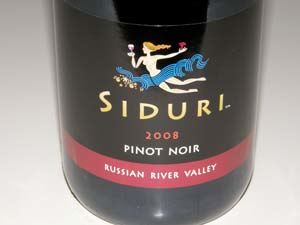 2008 Siduri Wines Russian River Valley Pinot Noir 14.3% alc., 1,782, $30, screw cap. A blend of fruit from six vineyards with nearly half coming from Keefer Ranch. Clones 114, 115, 667, 777, Pommard, 2A and 23. Plenty of single-vineyard juice in this wine as production was significantly ramped up in this vintage. · Lovely perfume of black cherries, grape soda, black currants, spice box and oak. Moderately rich core of black cherry fruit with underpinnings of sassafras, cola, root beer and oak toast. The ripest fruit in the 2008 appellation lineup. Juicy, with supple tannins and respectable persistence on the finish. Very good.
2008 Siduri Wines Sonoma Coast Pinot Noir 14.1% alc., 486 cases, $30, screw cap. · Impressively nuanced nose highlighting scents of strawberries, blackberries, underbrush, leather, lavender and exotic Eastern spices. Moderately rich in intensity with a savory and loamy bent and supporting oak. Smoothly textured with a fruity finish. Good.
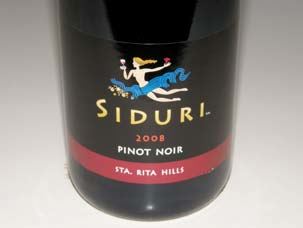 2008 Siduri Wines Sta. Rita Hills Pinot Noir 14.1% alc., 611 cases, $30, screw cap. · Deeply colored. Alluring scents of raspberries and cherries with hints of spice and herbs. Very tasty, penetrating and attention-getting dark red fruit core set off by perfectly balanced acids and tannins. The restrained oak is a perfect compliment. Very juicy with a fruity persistence on the bright finish. There are not many appellation wines from the Sta. Rita Hills and this is the best I have ever tasted. The wine really shows off the bright acidity and well-proportioned tannic structure that are typical of the wines of this appellation. Tasted twice with the same results. A stunning appellation wine at a very attractive price.
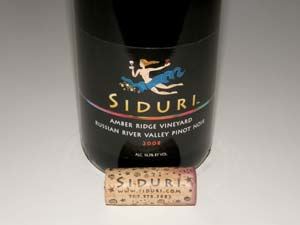 2008 Siduri Wines Amber Ridge Vineyard Russian River Valley Pinot Noir 14.3% alc., 147 cases, $45. · The nose on this wine is restrained and delicate at this stage showing aromas of black cherries and baked bread. Once you take a sip of this beauty, you are quickly seduced. Delicious flavor core of Bing cherries, pastry dough, cola and a touch of oak and an exotic spice note in the background. Great fruit intensity on the mid palate. The tannins are very supple making this very drinkable now. Silky, sensual and impeccably balanced, this wine sports the prettiest fruit in the lineup.
2008 Siduri Wines Keefer Ranch Vineyard Russian River Valley Pinot Noir 14.1% alc., 247 cases, $48. · Lightest in color in the lineup of 2008 Pinot Noirs tasted. Starts off shy, picking up more fruit intensity in the glass. Aromas of ripe strawberries, cherries, raspberries, red licorice, crushed rock and subtle oak. Oakkissed dark red fruits are a bit flat and linear. Juicy with lively acidity, supple tannins, and pleasing finesse. A definite oak influence should resolve with more aging. This wine hasn’t come together yet but is promising. Good.
2008 Siduri Wines Sonatera Vineyard Sonoma Coast Pinot Noir 14.1% alc., 396 cases, $48. · Aromas are more savory than fruity featuring notes of brier patch, toast, herbs, oak and cedar. A bit reluctant at first, developing more charm with time in the glass. Oak-kissed berry and plum fruit with an earthy, feral edge. Admirable silkiness and balance, with mild tannins and some finishing persistence. Good.
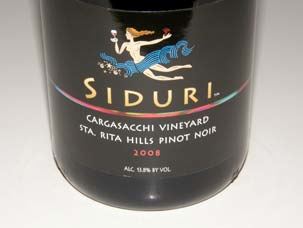 2008 Siduri Wines Cargassachi Vineyard Sta. Rita Hills Pinot Noir 13.8% alc., 146 cases, $49. · A young wine with shy aromas of dark fruits, smoke, and oak spice. Earthy and brooding, deep and dark, with rich flavors of plums and blackberries, touched by savory herbs, black tea and chicory. Plenty of tannin to shed. The creamy mouth feel is very sexy. Hard to get your arms around this one now, but this is an incredible effort that will repay a few years in the cellar.
Siduri wines are sold primarily through a mailing list at www.siduri.com. There is some retail and restaurant distribution. An informative newsletter is sent out monthly. There are two other 2008 Pinot Noirs in release, the Pisoni Vineyard Pinot Noir and the Pisoni Vineyard “Eddies Lot” Pinot Noir. A personal tasting experience is offered at the winery by appointment, 10:00 to 3:00, seven days a week. Phone 707-578-3882 or email pinot@siduri.com.
Pinot BriefsOregon Revels in Pinot Events (1) Yamhill-Carlton AVA tasting at Anne Amie Vineyards May 1, 2010. A select gathering of estate wineries including Anne Amie Vineyards, Belle Pente, Elk Cove Vineyards, Ken Wright Cellars, Lemelson Vineyards, Panther Creek, Shea Wine Cellars, Solena Estate, Soter Vineyards and Stag Hollow. Participating restaurants include Cuvée, La Rambla, Joel Palmer House, Nicks and Horseradish Cheese and Wine Bar. Tickets are only $20 in advance at www.yamhillcarltondistrict.com. (2) Wine Country Escape event at The Allison Inn & Spa on May 22. Chef Stephen Marshall’s creations paired with select wineries including Beaux Freres, Belle Pente, Ken Wright Cellars, Penner-Ash Wine Cellars and Shea Wine Cellars. Auction items to benefit the Yamhill-Carlton Booster Club include destination trips, winemaker dinners and rare wine lots. For tickets, catalog, and to reserve special lodging rates, visit www.carltontogethercares.com. (3) Pinot in the Pearl event in Portland will be held May 6. Wineries large and small from the Chehalem Mountains and Ribbon Ridge AVAs will bring 100 wines for tasting. Cost is $25 in advance at www.chehalemmountians.org. (4) Dundee Hills Passport event will be held April 17-18 featuring 30 wineries with exclusive access to vertical and barrel tastings, seminars and other events. Sponsored by the Dundee Hills Winegrowers Association, the event is only $10. Tickets may be purchased at www.dundeehills.org. (5) Spring on 47 (“Sip 47”) will celebrate 35 wineries and businesses along Highway 47 in the Northwest Willamette Valley. On April 24-25, there will be a weekend of wine releases, vertical flights, food pairings, pig roast, buffalo tasting, live music and other activities. The event is meant to encourage tourists to explore the alternative route. Tickets and information are available at www.sip47.com. (6) Taste Gorge Wine Week April 5-11. Grand Tasting April 5th in Portland, Passport Weekend April 9-11 and Gorge Winegrowers’ Celebration Fundraiser April 10. For passports and tickets, visit www.columbiagorgewine.com. (7) Farm to Fork Winemaker’s dinner with Josh Bergstrom and Paul De Lancellotti. $85 per person. The dinner honors the Slow Food USA Movement (www.slowfoodusa.org). For tickets, visit www.innatredhills.com. Russian River Valley Single Night Finally, an event for the younger generation. A single night, single vineyards, single bites, live auction, music and dancing. Saturday, June 5, 2010, at C. Donatiello Winery in Healdsburg. Taste single vineyard wines with winegrowers and winemakers. Adventure auction hosted by next generation winegrowers and winemakers. No-host bar of $25 and under wines from the Russian River Valley. Tickets are $45 in advance at www.rrvw.org.
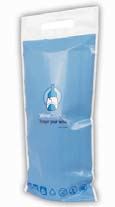 Wine Diaper This is an absorbent travel bag designed to make air travel safe for wine. It is made from the same absorbent material used in baby diapers. The Wine Diaper provides a protective padding for your wine to minimize the chance of breakage, but if breakage occurs, the core will soak up any spills. The sleeve simply slips over your wine bottle and fastens shut with a zipper seal. Priced at $14.99 for a 3-pack, the Wine Diaper can be personalized. Visit www.winediaper.com or see it in action at www.YouTube.com/user/WineDiaper. Pinot Noir 2010 A selection of photos from Pinot Noir 2010 are freely available to download at www.pinotnoir2010.co.nz/media/photo-gallery/. The full suite of photos is available on the photographer’s website for purchase (www.photo.woolf.co.nz). Audio and video clips of the presentations are also available on the media page of the Pinot Noir 2010 website, along with tasting notes and presentation slides for you to follow: www.pinotnoir2010.co.nz.
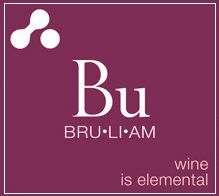 Bruliam Wines Blog One of the best blogs on the internet, this small producer of Pinot Noir takes no prisoners when it comes to disdain for wine snobbery. Commenting about their self-nomination for Best Writing on a Wine Blog Award in the annual Wine Blog Awards competition, they justified their nomination as thus: “To our knowledge, we’re the only wine producers who videoed ourselves barrel tasting our wine, declared we hated it, and then still posted the video. The owners’ 6-year-old son is named after a grape varietal, took his cork collection to kindergarten on sharing day, and was a grape farmer last Halloween. One of their 4-year-old daughters can routinely identify among Pinot Noir, Zinfandel and Cabernet Sauvignon tasted blindly.” Subscribe to the blog at www.bruliamwines.com.
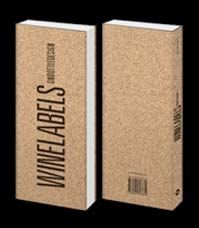 Fascinated by Wine Labels? The book, Wine Labels, is a compilation of labels from the past century and today. The bottles and the labels featured in the book are printed almost in real size for the optimal visualization of each label’s contents and its application on each bottle as a whole. Published this year and edited by Eduardo del Fraile, the 300 page book is available at http://www.indexbook.com/libro.php?1029.

Santa Barbara County Tastings (1) The annual Vintners’ Festival Weekend will be held April 16-19. Wineries will be hosting events throughout the weekend and over 130 members of the Vintner’s Association will be pouring on Saturday, April 17 at River Park in Lompoc. For tickets ($75), visit www.sbcountywines.com. (2) The Santa Barbara County Wine Futures Tasting will be held on Saturday, April 24 at The Olympic Collection Banquet and Conference Center in Los Angeles. Wineries participating include Alta Maria, Ampelos, Au Bon Climat, Demetria, Dierberg, Dragonette, Flying Goat, Foxen, Hitching Post, Jonata, Longoria, Melville, Native 9, Ojai, Paul Lato, Tyler, and more. Tickets are $58 and can be obtained by phoning 800-626-9463. (3) Fiddlefest returns to Fiddlestix Vineyard in 2010. All producers of Fiddlestix-designated Pinot Noir will pour their wines at the Fiddlestix Barn located at mile marker 7.28 on Santa Rosa Rd, in the middle of the Santa Rita Hills. Food from the Hitching Post and great fiddlin’ music. Profits benefit People Helping People in support of local farm workers. Tickets are $72.80 at www.fiddleheadcellars.com/events. (4) The Santa Barbara Wine Festival will be held at the Museum of Natural History in Santa Barbara on June 26. More than 70 Central Coast wineries will be pouring complemented by gourmet food provided by the best local chefs, caterers and bakers. Profits benefit the Santa Barbara Museum of Natural History. Tickets are $60 at www.sbcnature.org/tickets. Felton Road Receives High Honor at Pinot Noir 2010 Felton Road received the “Tipuranga Teitei o Aotearoa,” or “Grand Cru of New Zealand” award presented at New Zealand’s Pinot Noir 2010 festival in February. It was the first time this award was presented at the festival. The photo below shows winemaker Blair Walter holding the award and proprietor Nigel Greening addressing the audience.
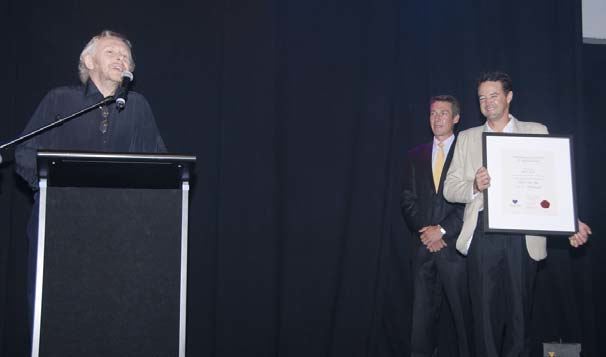 Sonoma County Wine Road Barrel Tasting Sets Records As many as 24,000 people participated in this year’s event, which was the 32nd. The low price of the event, $30, tended to attract many millennials who are not yet buying as much wine as the older crowds of the past, but this group will be the future core wine buyers. Make your plans now for the 33rd crowded, but fun event, to be held March 4-6, 2011. Jeff Pisoni New Winemaker at Fort Ross Vineyard & Winery Jeff Pisoni, the winemaker for Pisoni Vineyards in the Santa Lucia Highlands, follows in the footsteps of several prominent winemakers who have crafted Fort Ross wines in the past including Helen Keplinger (2007-2008), Ed Kurtzman (2003-2006) and Fred Scherrer (200-2004). The 50-acre Fort Ross Vineyard features 30 small blocks planted to Pinot Noir and Chardonnay that range in elevation from 1200 to 1700 feet on the extreme Sonoma Coast. The property is located one mile from the Pacific Ocean making it one of the closest vineyards to the coast in California. Linda Schwartz established the Fort Ross Vineyard along with her husband, Lester Schwartz, in 1994. Santa Maria Valley AVA Set to Expand Winegrowers in Santa Maria Valley have asked the TTB to add 18,700 acres to their AVA. Currently at 97,483 acres, the Santa Maria Valley AVA spans parts of southern San Luis Obispo and northern Santa Barbara counties. The proposed added acreage will encompass some vineyards which are now bisected such as Solomon Hill Vineyard and Good Child Vineyard. The new proposed AVA expansion also adds newer vineyards that have been developed since the AVA was first approved in 1981. California Initiative Proposes Huge Increase in Excise Tax A proposition, backed by Josie Whitney and Kent M. Whitney and cleared by Secretary of State Debra Bowen, is gathering signatures to be included on the next California ballot. The excise taxes on wine, beer and spirits would be pushed to astonishing heights: the excise tax on a bottle of wine would be raised from $0.04 to $5.11 (an increase of 12,600 percent) and the tax on a six-pack of beer would increase from $0.11 to $6.08. Reportedly the $7 to $9 billion in revenue raised would be used to support alcohol related programs and services. This proposition is a potential disaster for the wine industry in California and would reduce state overall tax revenue as consumers would no doubt significantly reduce their alcoholic beverage purchases. Read more at www.ballotpedia.org. New Free Nat Decants Wine & Food Mobile App This new mobile app for the iPhone, iPad Touch, BlackBerry, Droid, and other smart phones, has 380,000 professionally tested wine and food pairings that were in the first version of the app, and thousands of wine reviews, recipes, articles, glossary terms, virtual cellar notes, winery directions and other wine related information which has been added. You can access the new app by visiting www.nataliemaclean.com/mobileapp. Natalie MacLean is an independent wine journalist who has won four James Beard Journalism Awards.
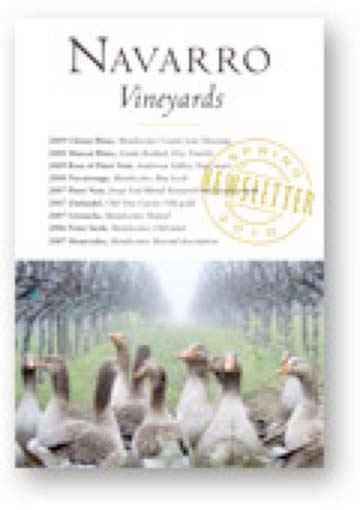 Best Winery Newsletter Navarro Vineyards & Winery publishes a newsletter quarterly that is the most impressive example of its kind in the business. More like a mini book at sixteen pages, it is filled with well-written and detailed information on the happenings at Navarro Vineyards and the wines available for purchase. Remarkably, Navarro has been sending out this newsletter to customers for what I believe to be over 25 years. This family owned and operated winery has been producing wine since 1974. Navarro Vineyards offers an extensive array of varietals and every one is an outstanding example of its type. The Pinot Noirs are consistently fine as are the Chenin Blanc, Riesling, Chardonnays, Sauvignon Blanc, Pinot Gris, Gewürztraminer, Edelzwicker, Zinfandel, Mourrvedre and Grenache. As a bonus, their wines are always extremely well-priced and their customer service is laudable. The three 2007 Pinot Noirs are now available and I would snap up a mixed case as these are among the best Pinot Noirs the Anderson Valley has to offer. Visit the website at www.navarrowine.com and sign up for the newsletter or read it online. DRC Adds New Wine Domaine de la Romanee-Conti (DRC) is producing new Cote de Beaune red wines in 2009. DRC signed a lease with Domaine Prince de Merode to farm and produce wine from three of Merode’s grand cru properties in Corton: Clos du Roi, Bressandes and Renards. All of DRC’s other red properties are in the Cote de Nuits. DRC does have the grand cru white, Le Montrachet, in the Cote de Beaune. Wine Social Media Exploding VinTank, a digital think tank for the wine industry, has released data regarding the impact of social media on the wine industry (download free at www.VinTank_SocialMediaReport.pdf). Social media is estimated to be producing twice the content of print media. The top 20 wine bloggers have a larger audience than the Wine Spectator Online and are growing at a faster rate. Each day in April 2009, Cruvee.com estimated that there were 153 blog posts, 1,420 forum posts, and 7,896 microblog (Twitter) posts on the topic of wine. An important challenge for all wine social networks is the provide accurate data. Burgundy Bootcamp Becky Wasserman and her husband, Russel Hone, host wine camps in Burgundy for serious burgphiles. In 2009, programs included five days with Allen Meadows for a master class session on the wines of Vosne-Romanee ($17,648), and Wasserman’s session on Burgundy basics with visits to many vineyards ($3,999). “Campers” stay in a hotel in Bouilland, France, not far from Wasserman’s farm. Schedule and details are at www.burgundybootcamp.com. The schedule for 2010 is not posted so inquire. Time to Buy That Oregon Vineyard or Winery? According to Oregon Wine News (March 2010), there are a large number of Oregon vineyard and winery properties on the market, including 10 wineries and 28 vineyards as of February, 2010. The offerings range in value from $260,000 to $7 million for a winery and between $485,000 and $6,900,000 for vineyard properties. There may be several other wineries and vineyards available that are not advertised. Several reasons are offered for this buyer’s opportunity. Many children of winegrowers and winery owners are choosing not to pursue their family’s business. The first wave of Oregon grape farmers are retiring. Some producers are struggling with cash flow as the recession, a glut of Oregon wine and poor press about the 2007 vintage have led to less wine consumption. Visit www.oregonvineyardproperty.com. SonomaDiscoveries.com A new website to guide visitors throughout all of Sonoma County. Comprehensive listings of lodging, dining, shopping, wineries and spas by region, plus an events calendar that displays a wide array of festivals, entertainment, classes and other events. Visit www.sonomadiscoveries.com. Recent Articles on Pinot Noir Are Required Reading (1) Allen Meadows wrote the cover story in the March 2010 edition of Decanter titled “Why I Love Pinot.” Meadows reveals that his Pinot Noir epiphany came in 1976 when he tried a bottle of 1967 Richebourg from Domaine de la Romanee Conti. He says, “That Richebourg moved me so profoundly that I became fascinated with all things Pinot Noir.” He makes many salient points in the article, including, “Pinots that are held in the highest regard are those which can consistently speak of their origins and which no amount of technological intervention or winemaking sophistry can replicate.” Visit www.decanter.com. (2) An article appearing in the March 2010 edition of ForbesLife, “Pinot Noir’s Promised Land,” by Richard Nalley, was the best summary of the Sonoma Coast region that I have ever read. I wished that I had written it myself. In only four brief pages, Nalley beautifully explains why the far Sonoma Coast is the American Burgundy. He quotes noted winemaker, Ted Lemon, “There is no place I’ve ever heard of like it. The coast is a laboratory for place-specific winemaking.” The author’s choice of top 10 Sonoma Coast Pinot Noirs is right on (Anthill Farms Peters Vineyard, Cobb Coastlands Vineyard, Evening Land Occidental Vineyard, Failla Occidental Ridge Vineyard, Flowers Frances Thompson Vineyard, Hirsch M, Littorai Thieriot Vineyard, Peay Scallop Shelf, Radio-Coteau La Neblina, and Williams Selyem Precious Mountain). Visit www.forbes.com. (3) Winemaker and vineyardist at Clos Pepe Vineyard in Santa Rita Hills, Wes Hagen, wrote an article titled “Pinot Noir Transverse Transcendence: How the Central Coast’s Santa Rita Hills came to produce a world-class varietal,” published in the Los Angeles Times April 4, 2010 (www.latimesmagazine.com). Hagen describes his wine epiphany as a 1972 Domaine Trapet Chapelle- Chambertin, but decided he was better off focusing on producing wines that represented the soils of the Sta. Rita Hills appellation rather than trying to duplicate Burgundy. Accompanied by beautiful photography, the article captures the spirit of the Sta. Rita Hills region. Hagen admits to the region not having the pomp of, say, Napa Valley, but is exuberant about the area’s lack of stuffiness. He urges wine enthusiasts, “We hope you’ll come for a visit while we’re still down to earth.” Hagen pens the blog, WineMaker Magazine - (Another) Year in the Vineyard at www.winemakermag.com/blogs/another-year-in-the-vineyard-a-wine-blog-by-weshagen- of-clos-pepewinemaker.html
The Line Wines Neil Koch began his winemaking career at Seavey Vineyards and Vineyard 29 in 2002 working with Anna Montecelli and Philippe Melka. After finishing his degree at California State University at Fresno, he was hired at Lewis Cellars, where he helped craft world class Cabernet Sauvignon, Merlot and Chardonnay for two vintages. He was fully in-charge of the Chardonnay program at Lewis Cellars. Despite working for top Cabernet Sauvignon producers in the Napa Valley, his passion grew for Burgundy varieties after numerous trips to the Burgundy region of France. He decided to launch his own wines under The Line Wines label. Along with this new project, Neil works as an enologist and cooperage consultant for four coopers based in France. His other passion is motorcycle racing (above at Infineon Raceway in Sonoma) and the name of his winery reflects this. Neil’s latest Pinot Noir release from the Sonoma Coast is quite impressive. I am often asked, “What is a good inexpensive Pinot Noir? The answer is always a challenge as they are far and few between, but Neil’s wine fits the bill.
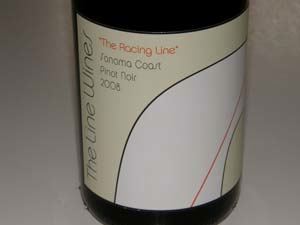 2008 The Line Wines “The Racing Line” Sonoma Coast Pinot Noir 14.8% alc., 150 cases, $34. Sourced from primarily Gap’s Crown Vineyard on the western side of Sonoma Mountain in the Petaluma Gap. A blend of clones 115, 667 and Pommard. · Deep, dark reddish-purple color in the glass. Rich aromas of dark wild berries including strawberries with a hint of juniper berry. Moderately opulent featuring satisfying ripe purple fruits with a judicious touch of oak and accents of coffee and evergreen. Almost viscous in texture, with healthy tannins that will integrate over time. A man’s Pinot that is a dead ringer for Kosta Browne’s bottling from this vineyard. Good.
The wine is available for purchase online at www.thelinewines.com. This is an opportunity to support a young winemaker destined for success on his way up and drink some good Pinot at the same time. |